Investigations on the Performance of Grounding Device with Spike Rods (GDSR) with the Effects of Soil Resistivity and Configurations
Abstract
1. Introduction
2. Experimental Arrangement
3. Experimental Results
3.1. Time to Peak Current
3.2. Time for Current to Discharge to Zero
3.3. Impulse Impedance, Zimpulse
4. Simulation Work
4.1. Simulation Set up
4.2. Computed Results
5. Conclusions
Author Contributions
Funding
Conflicts of Interest
References
- IEEE. IEEE Standard 142: 2007—IEEE Recommended Practice for Grounding of Industrial and Commercial Power Systems; IEEE: Piscataway, NJ, USA, 2007. [Google Scholar]
- BSI. BS 7430-1998, ’Earthing’, British Standard Code of Practice; BSI: London, UK, 2013. [Google Scholar]
- IEEE. IEEE Std 80-2013, IEEE Guide for Safety in AC Substation Grounding; IEEE: Piscataway, NJ, USA, 2013. [Google Scholar]
- IEEE. IEEE Std 81-2012, IEEE Guide for Measuring Earth Resistivity, Ground Impedance, and Earth Surface Potentials of a Ground System; IEEE: Piscataway, NJ, USA, 2012. [Google Scholar]
- Abdul Ali, A.; Ahmad, N.; Mohamad Nor, N.; Reffin, M.; Syed Abdullah, S. Investigations on the performance of a new grounding device with spike rods under high magnitude current conditions. Energies 2019, 12, 1138. [Google Scholar] [CrossRef]
- Yunus, S.; Mohamad Nor, N.; Agbor, N.; Abdullah, S.; Ramar, K. Performance of earthing systems for different earth electrode configurations. IEEE Trans. Ind Appl. 2015, 51, 5335–5342. [Google Scholar] [CrossRef]
- Reffin, M.S.; Mohamad Nor, N.; Ahmad, N.N.; Abdullah, S.A. Performance of practical grounding systems under high impulse conditions. Energies 2018, 11, 3187. [Google Scholar] [CrossRef]
- Reffin, M.; Ali, A.; Mohamad Nor, N.; Ahmad, N.; Abdullah, S.; Mahmud, A.; Hanaffi, F. Seasonal influences on impulse characteristics of grounding system for tropical countries. Energies 2019, 12, 1334. [Google Scholar] [CrossRef]
- Haddad, A.; Griffiths, H.; Ahmeda, M.; Harid, N. Experimental investigation of the impulse characteristics of practical ground electrode systems. In Proceedings of the International Conference on High Voltage Engineering and Application (ICHVE), New Orleans, LA, USA, 11–14 October 2010; pp. 469–472. [Google Scholar]
- Sonoda, T.; Takesue, H.; Sekioka, S. Measurement on surge characteristics of grounding resistance of counterpoises for impulse currents. In Proceedings of the 25th International Conference on Lightning Protection, Rhodes, Greece, 18–22 September 2000; pp. 411–415. [Google Scholar]
- Sekioka, S.; Hayashida, H.; Hara, T.; Ametani, A. Measurement of grounding resistance for high impulse currents. IEE Proc. Generat. Transm. Distrib. 1998, 145, 693–699. [Google Scholar] [CrossRef]
- Yang, S.; Zhou, W.; Huang, J.; Yu, J. Investigation on impulse characteristic of full-scale grounding grid in substation. IEEE Trans. Electromagn. Compat. 2018, 60, 1993–2001. [Google Scholar] [CrossRef]
- Guo, D.; Clark, D.; Lathi, D.; Harid, N.; Griffiths, H.; Ainsley, A.; Haddad, A. Controlled large-scale tests of practical grounding electrodes—Part II: Comparison of analytical and numerical predictions with experimental results. IEEE Trans. Power Del. 2014, 29, 1240–1248. [Google Scholar] [CrossRef]
- Stojkovic, Z.; Savic, M.S.; Nahman, J.M.; Salamon, D.; Bukorovic, B. Sensitivity analysis of experimentally determined grounding grid impulse characteristics. IEEE Trans. Power App. Syst. 1998, 13, 1136–1141. [Google Scholar] [CrossRef]
- Elzowawi, A.; Haddad, A.; Griffiths, H.; Clark, D. Investigation of soil ionization propagation in two-layer soil samples. In Proceedings of the 50th International Universities Power Engineering Conference (UPEC), Stoke-Upon-Trent, UK, 1–4 September 2015; pp. 1–5. [Google Scholar]
- Visacro, S.; Alipio, R.; Murta Vale, M.H.; Pereira, C. The response grounding electrodes to lightning currents: The effect of frequency-dependent resistivity and permittivity of soil. IEEE Trans. Power Del. 2011, 53, 401–406. [Google Scholar] [CrossRef]
- Visacro, S.; Alipio, R. Frequency dependence of soil parameters: Experimental results, predicting formula and influence on the lightning response of grounding electrodes. IEEE Trans. Power Del. 2012, 27, 927–935. [Google Scholar] [CrossRef]
- Alipio, R.; Visacro, S. Impulse efficiency of grounding electrodes: Effect of frequency-dependent soil parameters. IEEE Trans. Power Del. 2014, 29, 716–723. [Google Scholar] [CrossRef]
- CIGRE. Impact of Soil-parameter Frequency Dependence on the Response of Grounding Electrodes and on the Lightning Performance of Electrical Systems; Technical Brochure 781; CIGRE: Paris, France, 2019. [Google Scholar]
- Current Distribution, Electromagnetic Interference, Grounding and Soil Structure Analysis (CDEGS) Manual. Available online: https://www.sestech.com/common/distro_docs/16.0/PDF/GetStart.pdf (accessed on 25 February 2020).
- Telekom Malaysia Berhad and Multimedia Unviersity. Experiment and Equipment Arrangement (Set Up) For Grounding Assessment under High Impulse Conditions. MALAYSIA—Patent Application No. Pl 2020002177, 30 April 2020. [Google Scholar]
- Mohamad Nor, N.; Haddad, A.; Griffiths, H. Characterisation of ionisation phenomena in soils under fast impulses. IEEE Trans. Power Del. 2006, 21, 353–361. [Google Scholar]
- Snowden, D.P.; Erler, J.W. Initiation of electrical breakdown of soil by water vaporization. IEEE Trans. Nucl. Sci. 1983, 30, 4568–4571. [Google Scholar] [CrossRef]
- Higazi, K.A.; Chalmers, J.A. Measurements of atmospheric electrical conductivity near the ground. J. Atmos. Terr. Phys. 1966, 28, 327–330. [Google Scholar] [CrossRef]
- Srisakot, S.; Dana, G.; Mohamad Nor, N.; Griffiths, H.; Haddad, A. Effect of frequency on soil characteristics. In Proceedings of the 36th Universities Power Engineering Conference (UPEC), Swansea, UK, 12–14 September 2001; p. 156. [Google Scholar]
- Harid, N.; Griffiths, H.; Haddad, A. Effect of ground Return path on impulse characteristics of earth electrodes. In Proceedings of the 7th Asia-Pacific International Conference on Lightning, Chengdu, China, 1–4 November 2011. [Google Scholar]
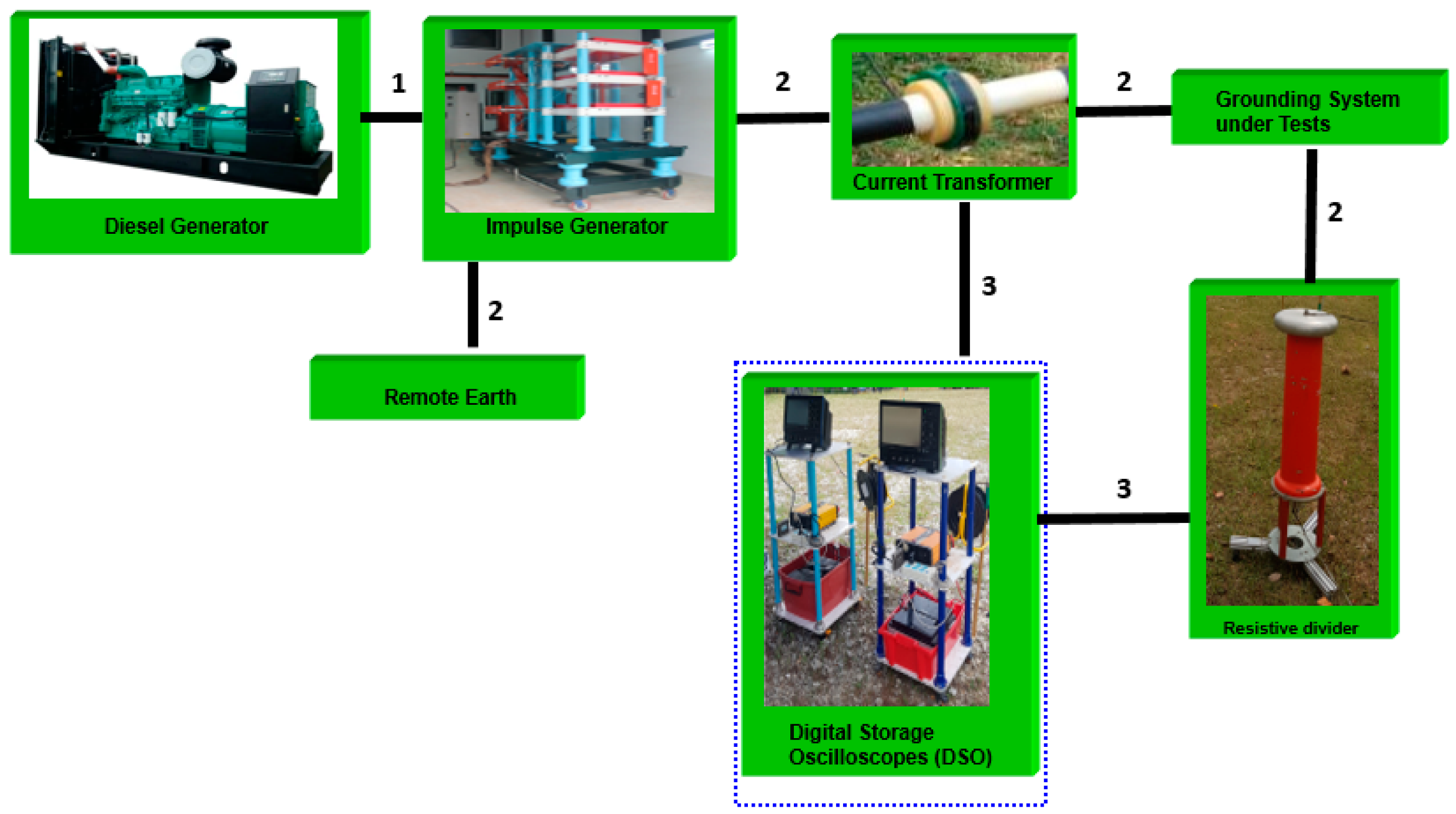
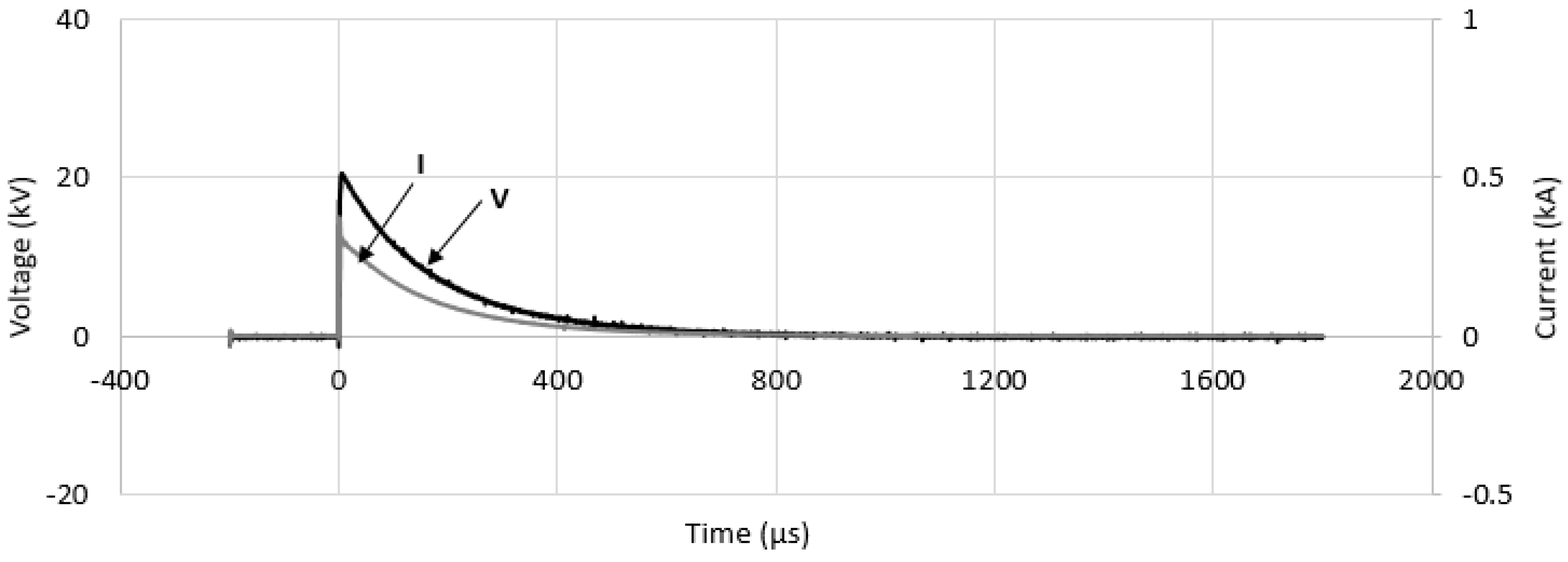
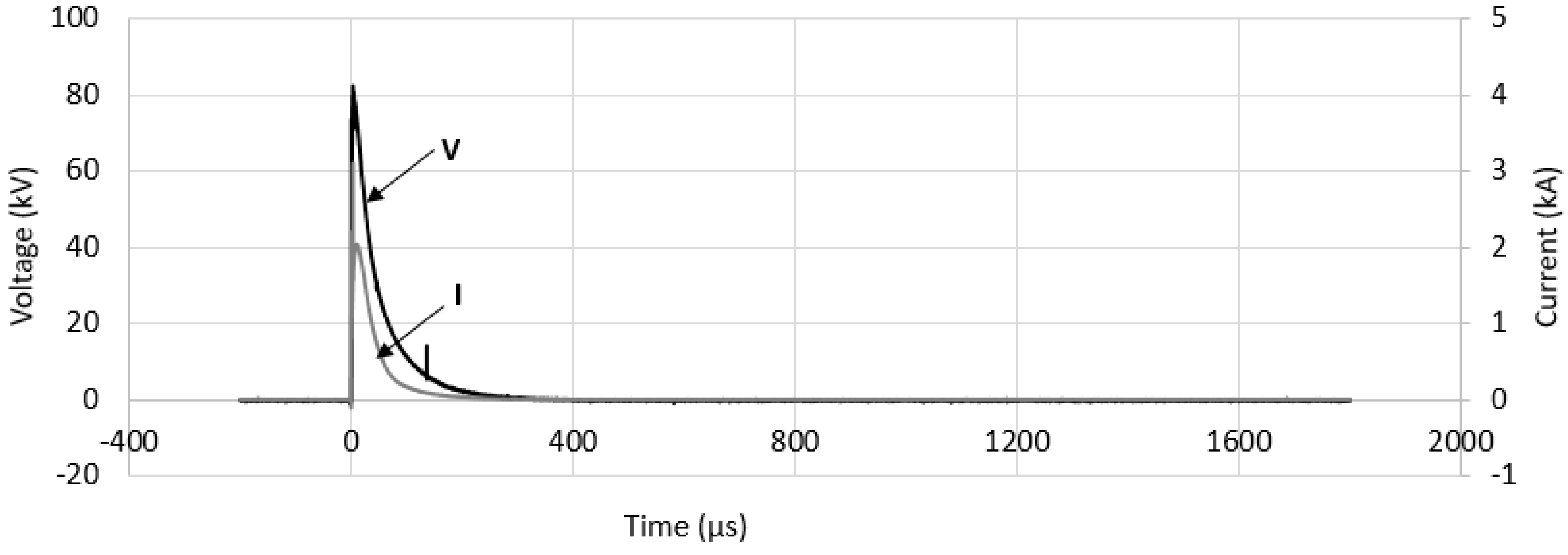
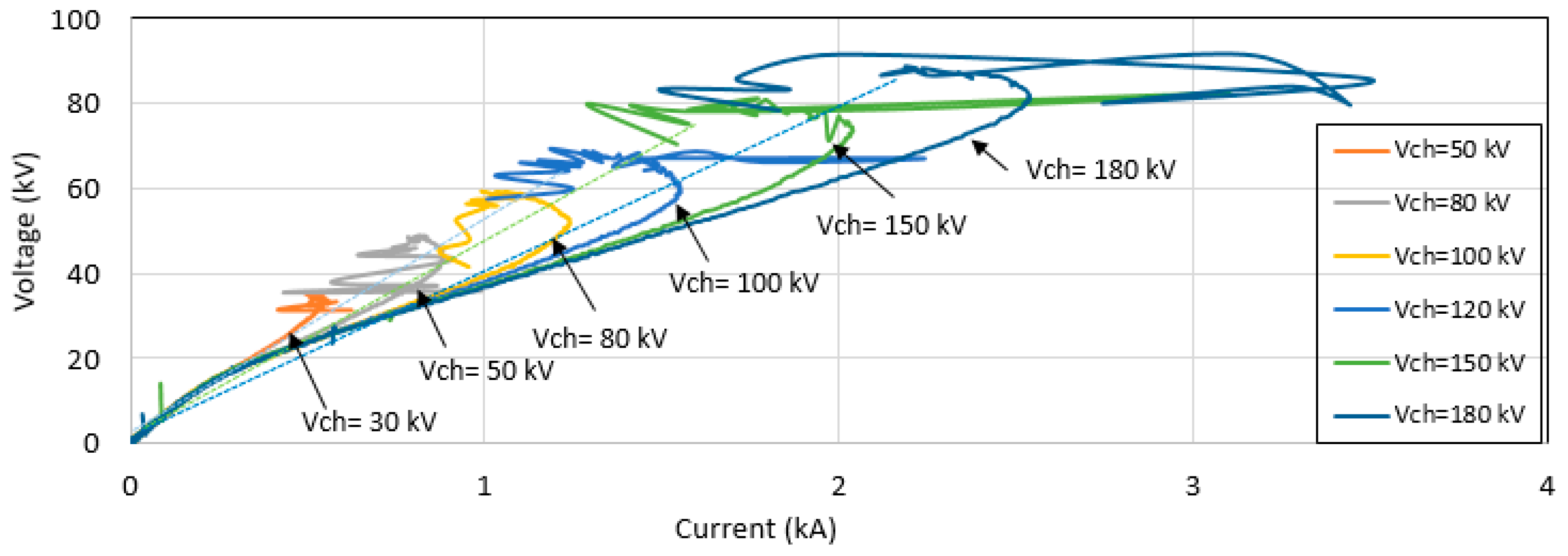
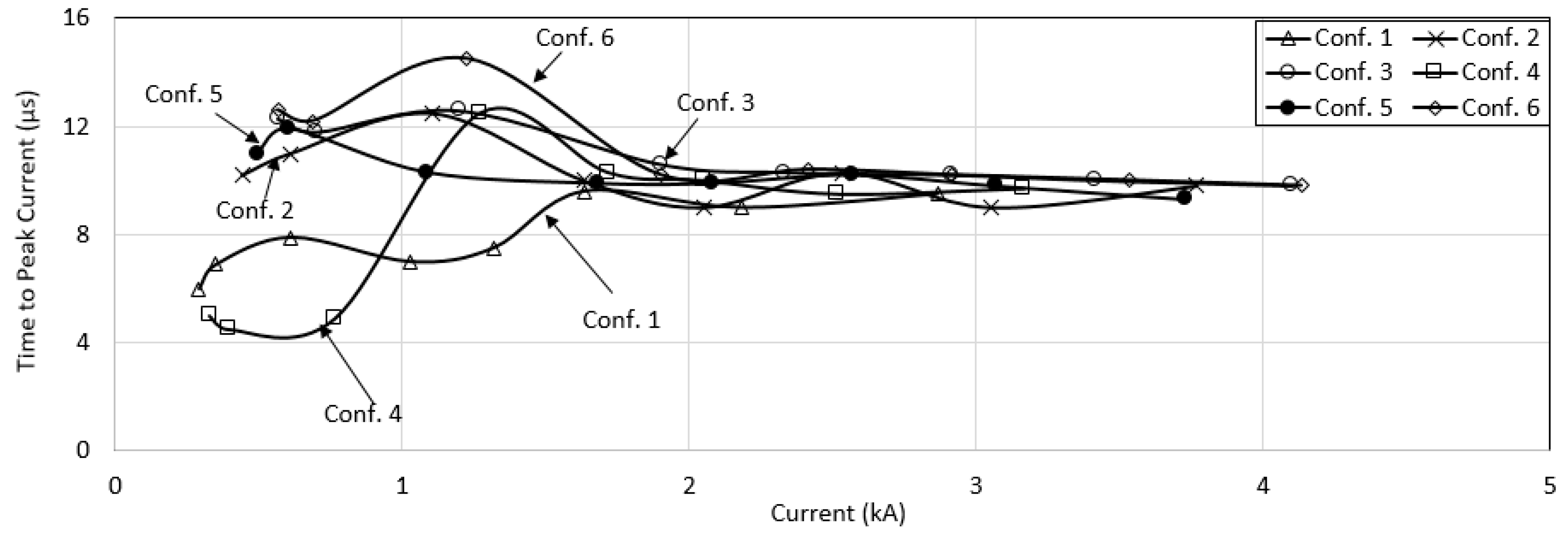



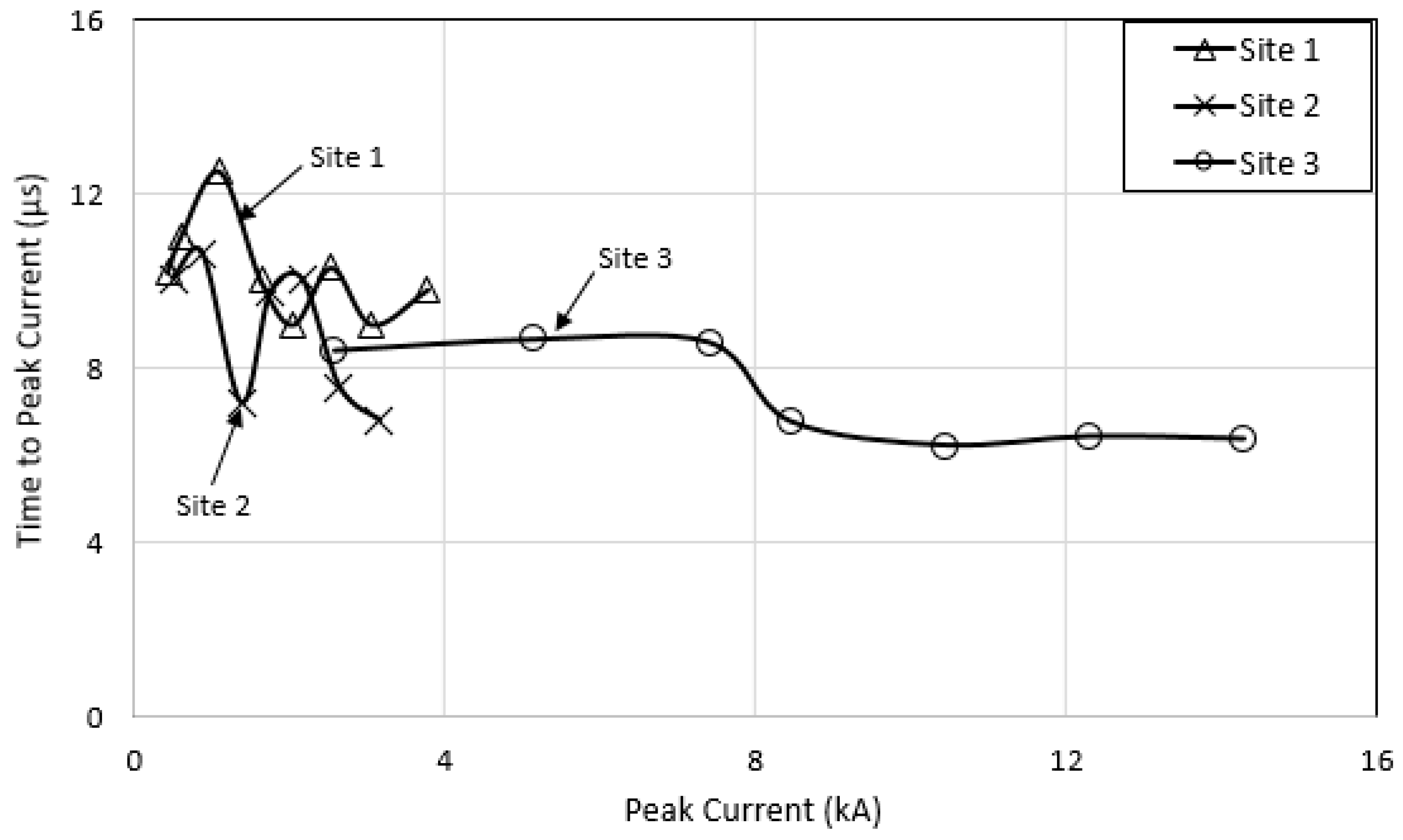
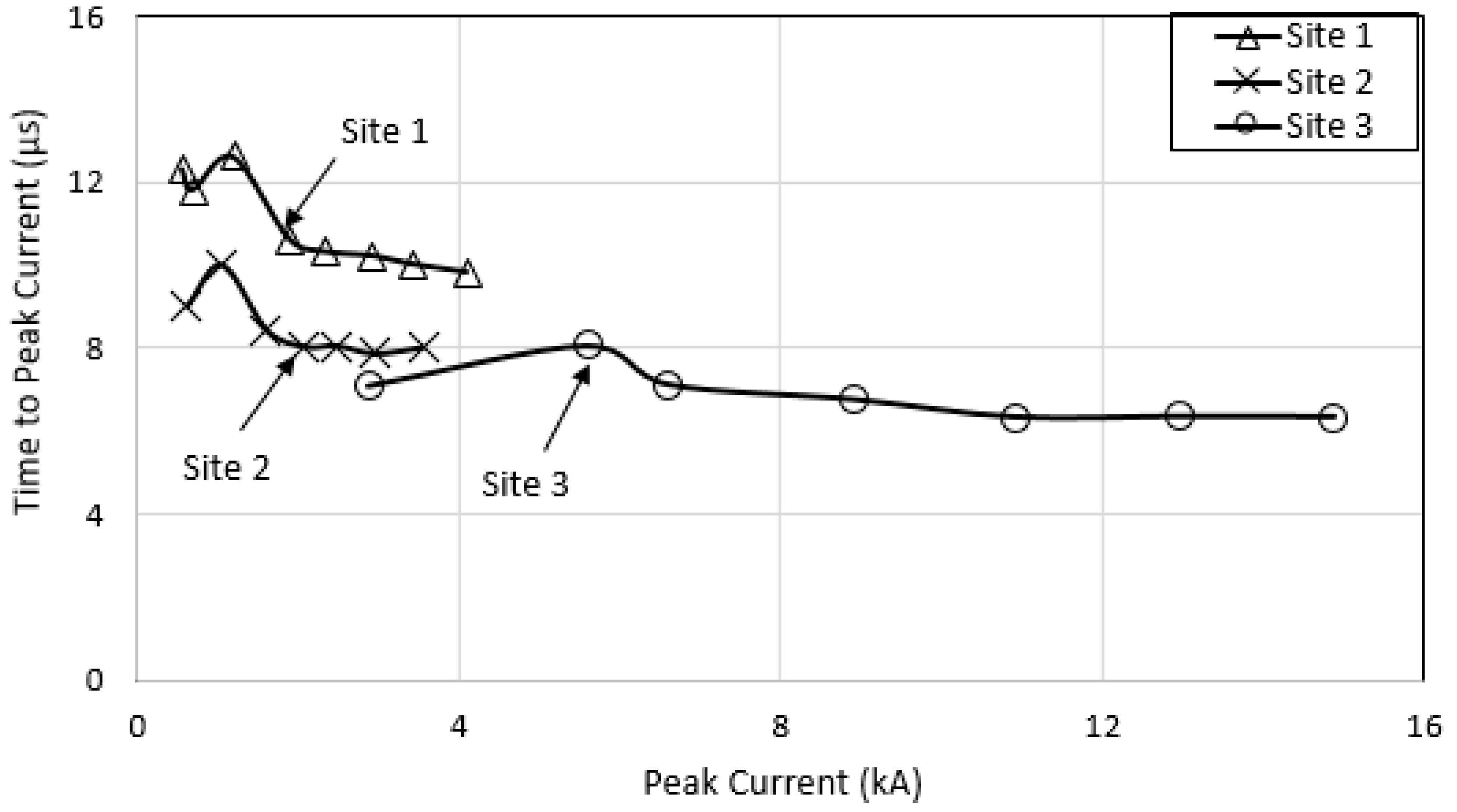
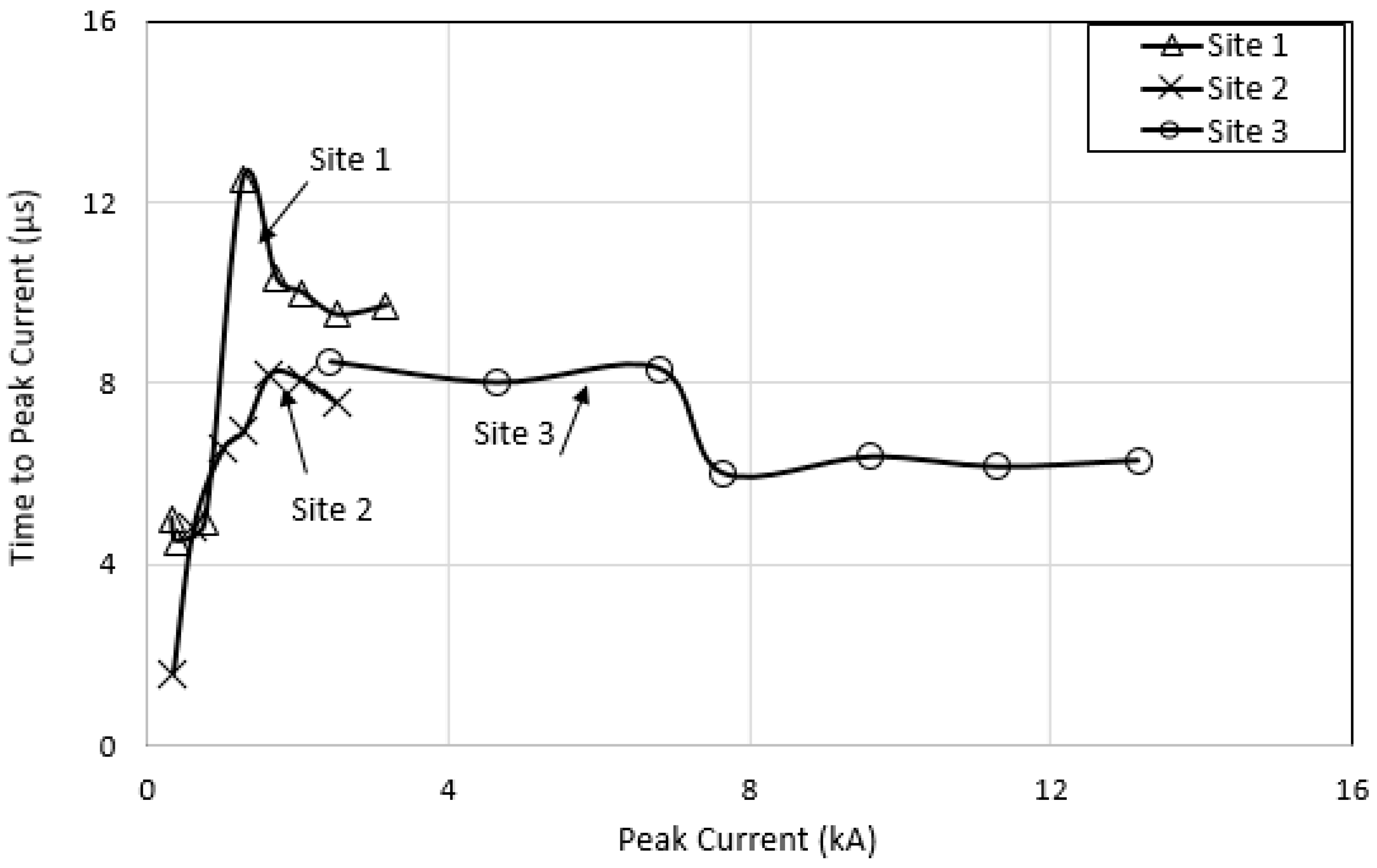
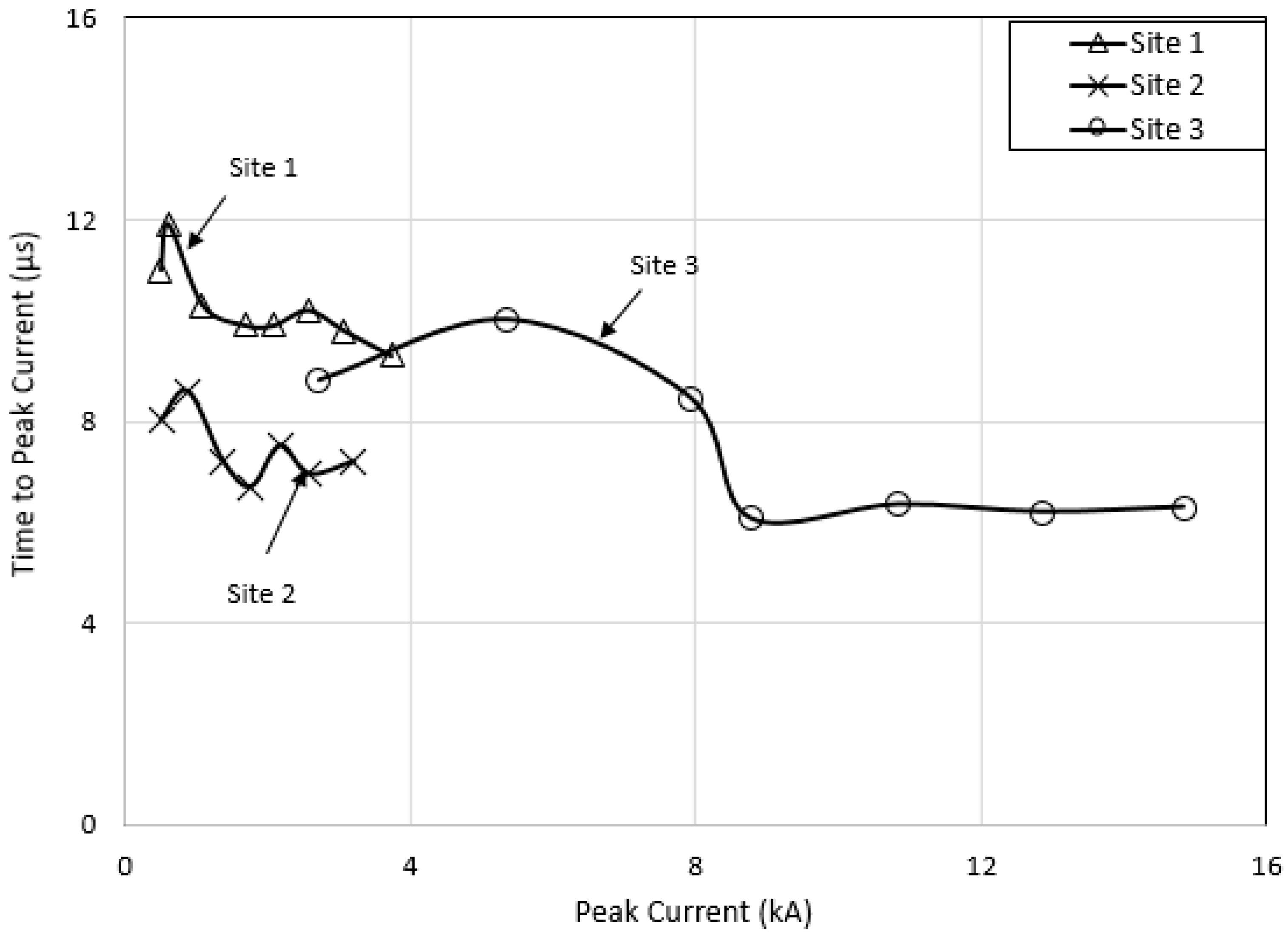



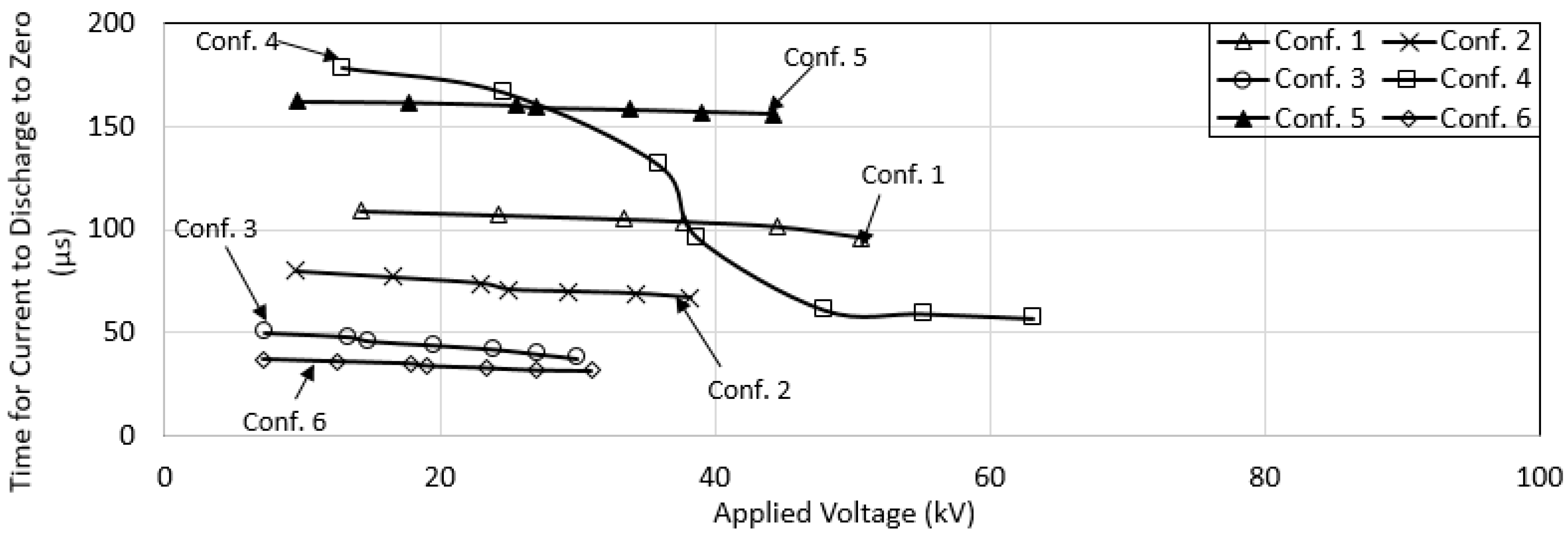
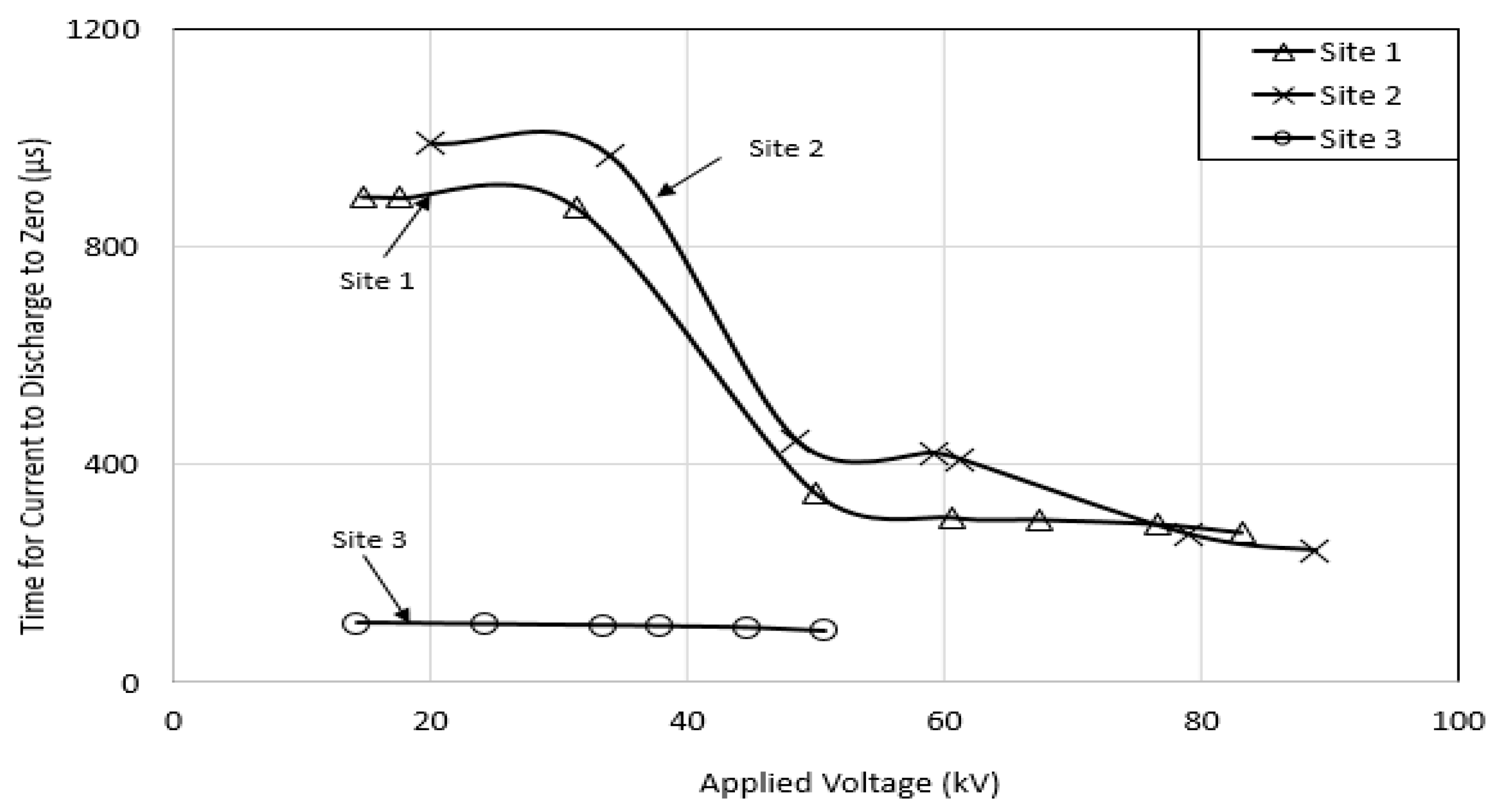
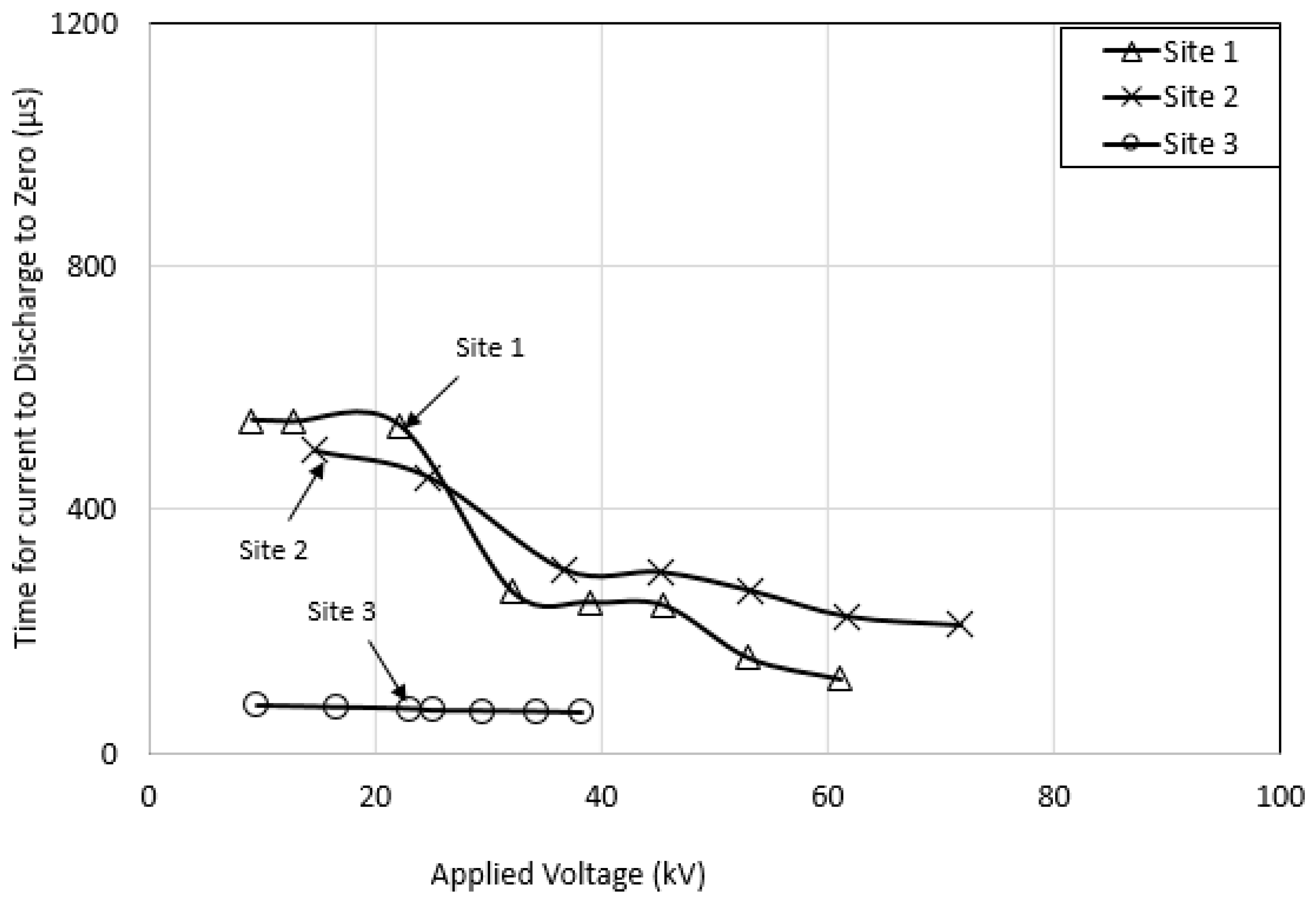
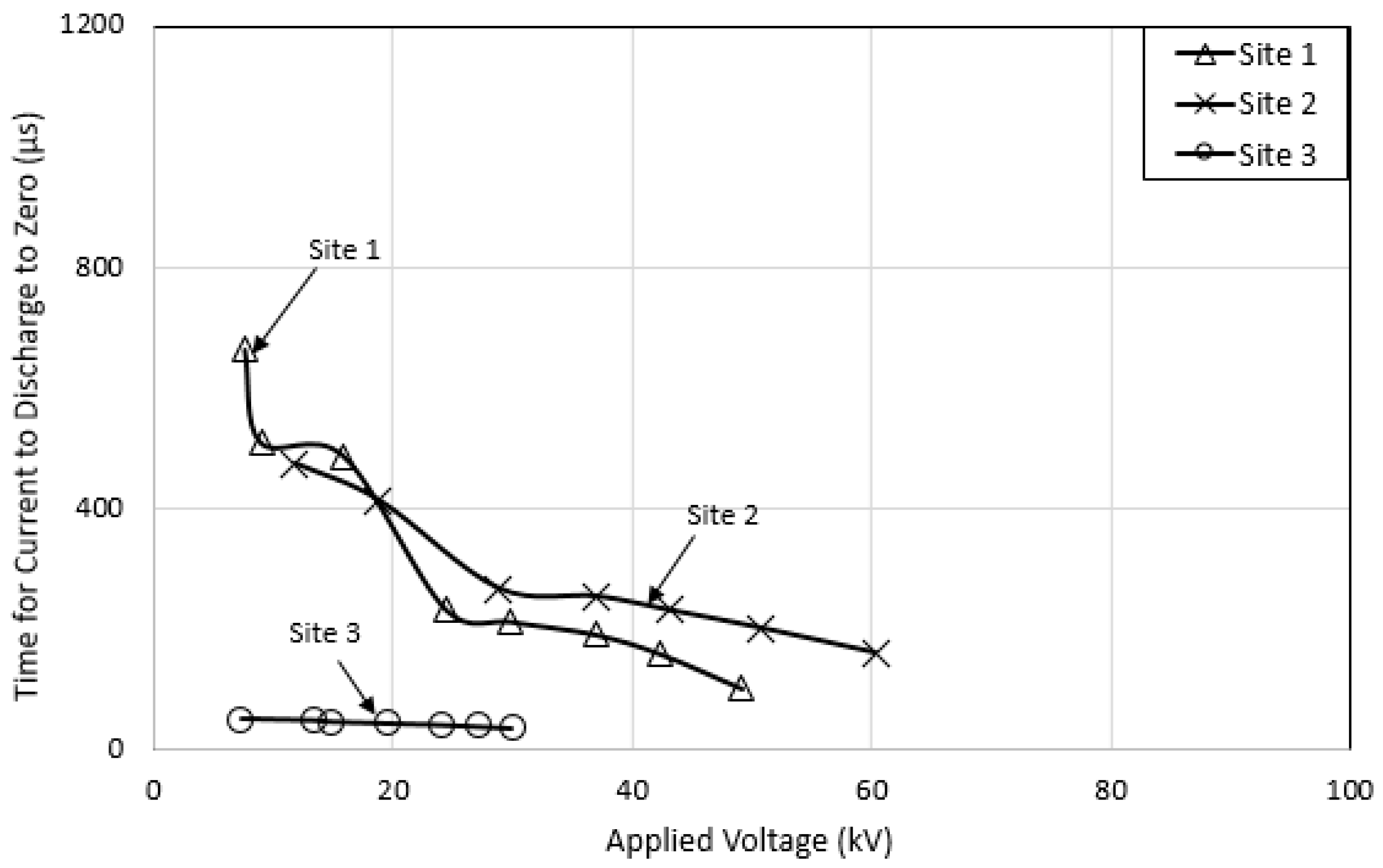
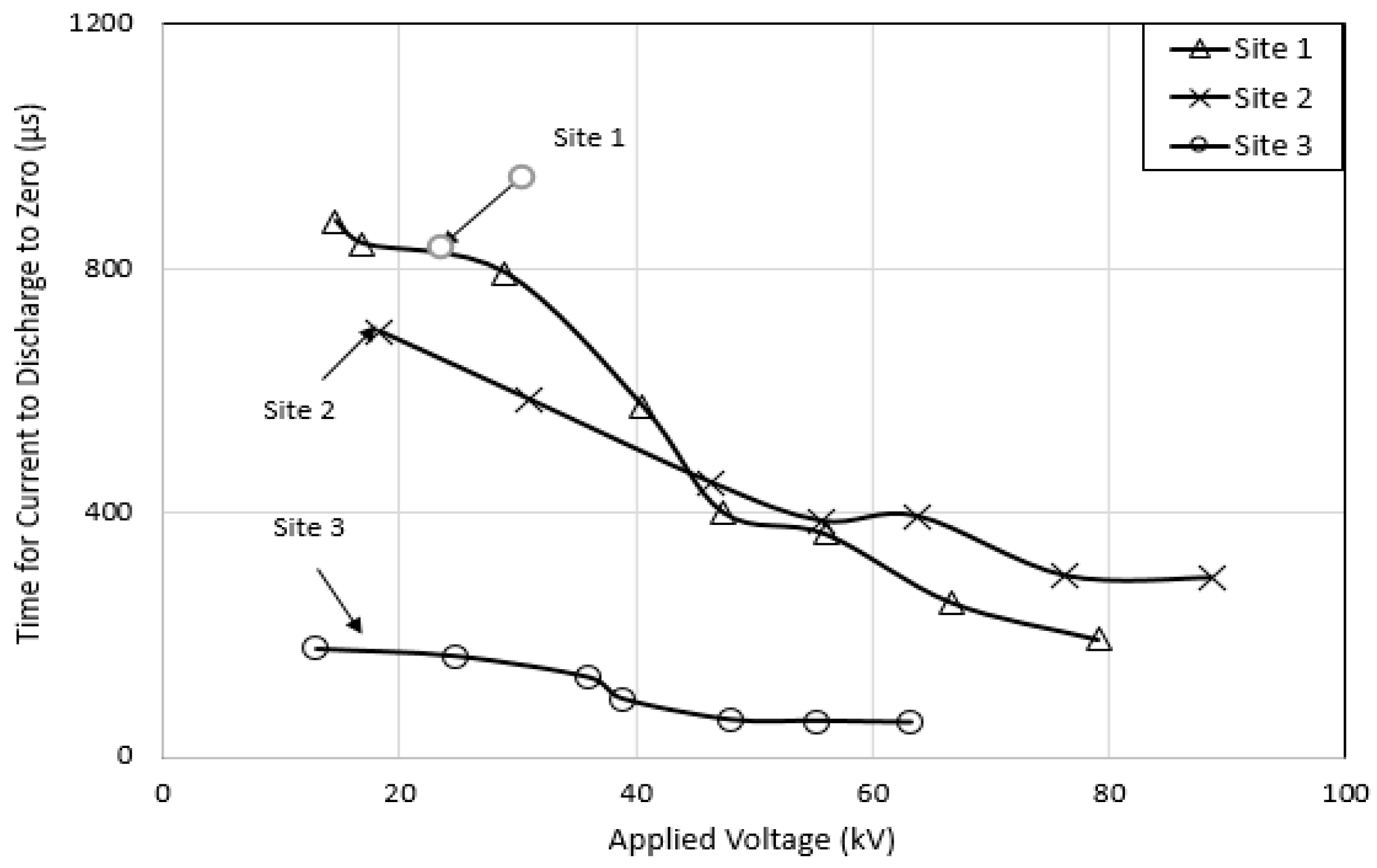
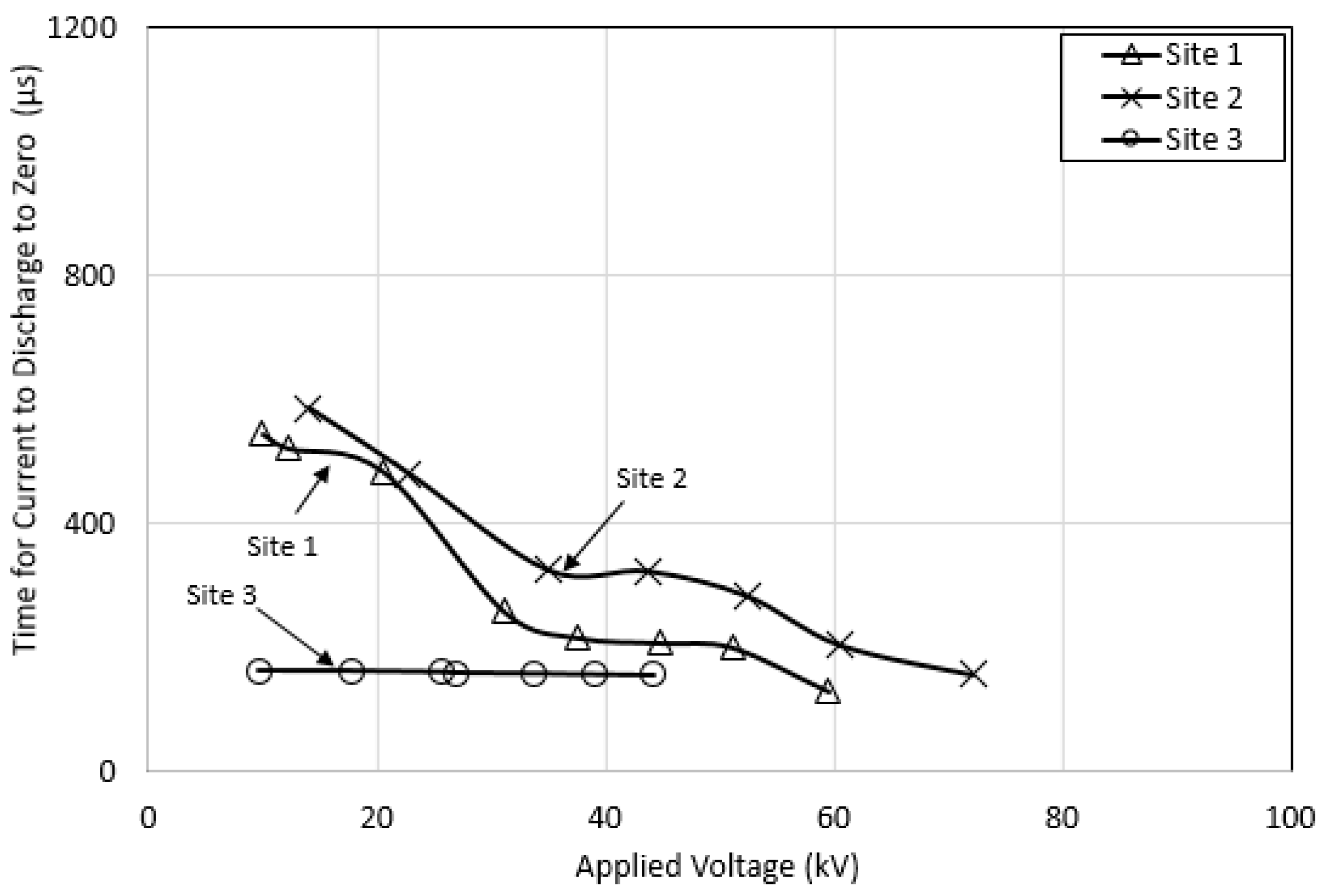
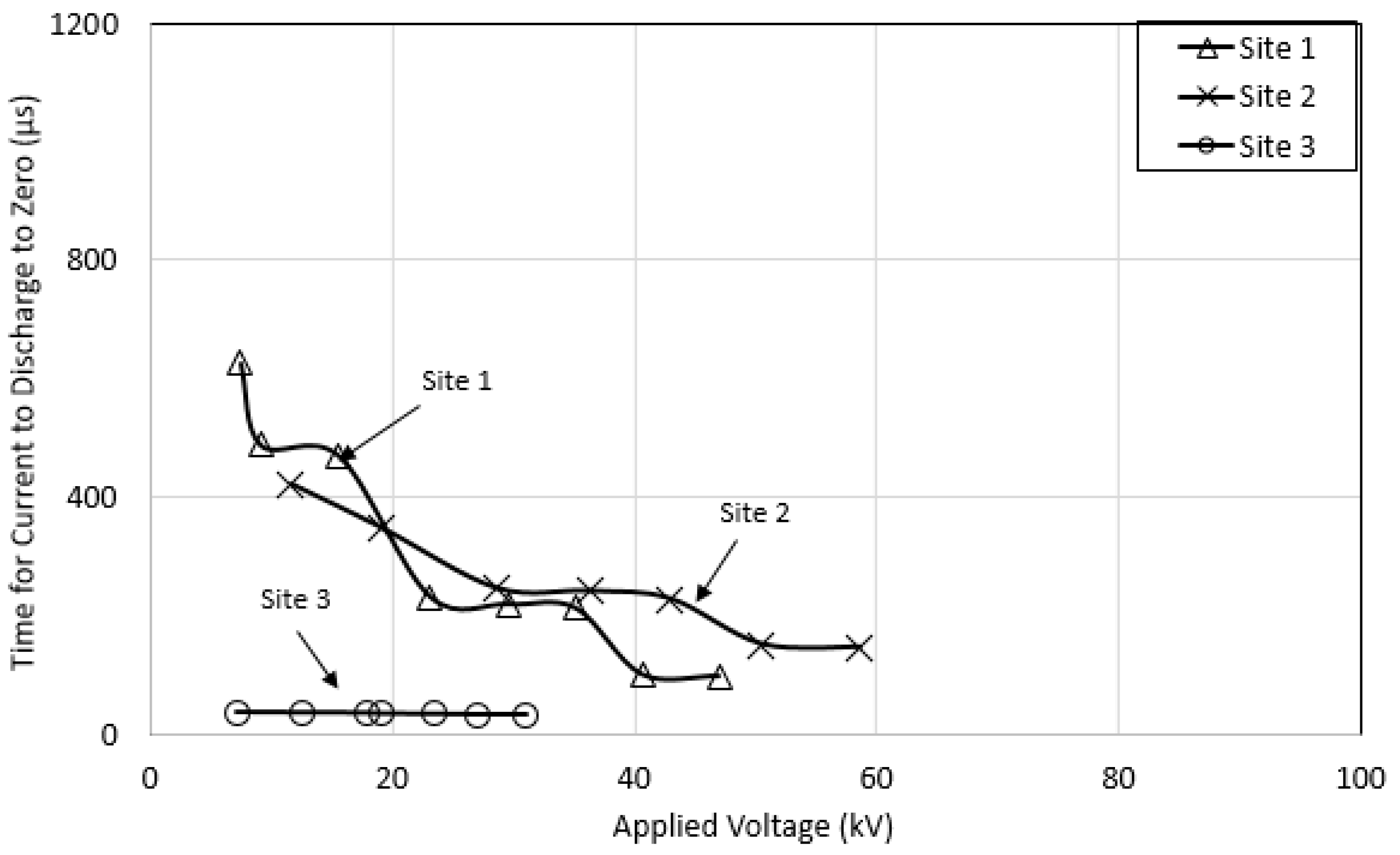



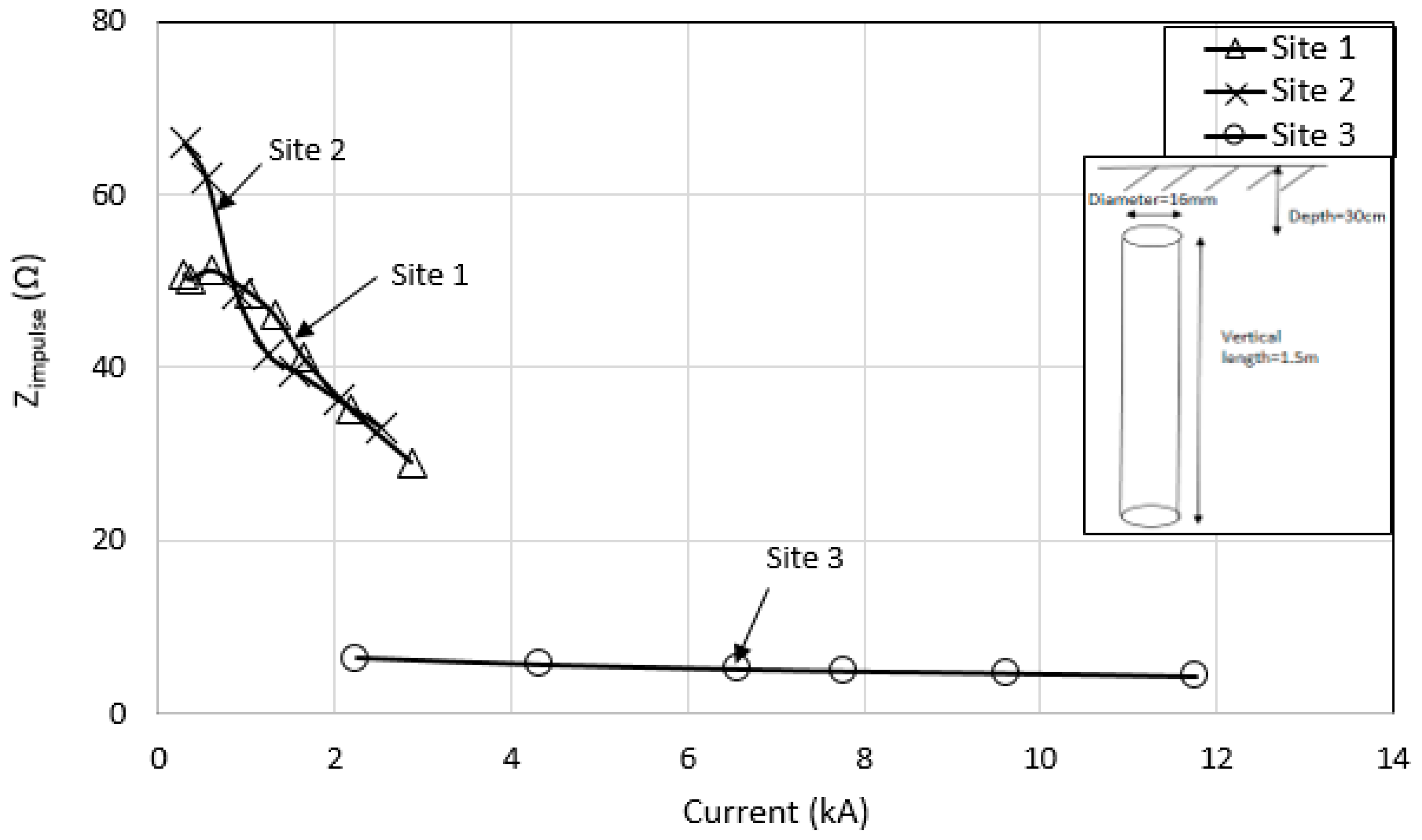
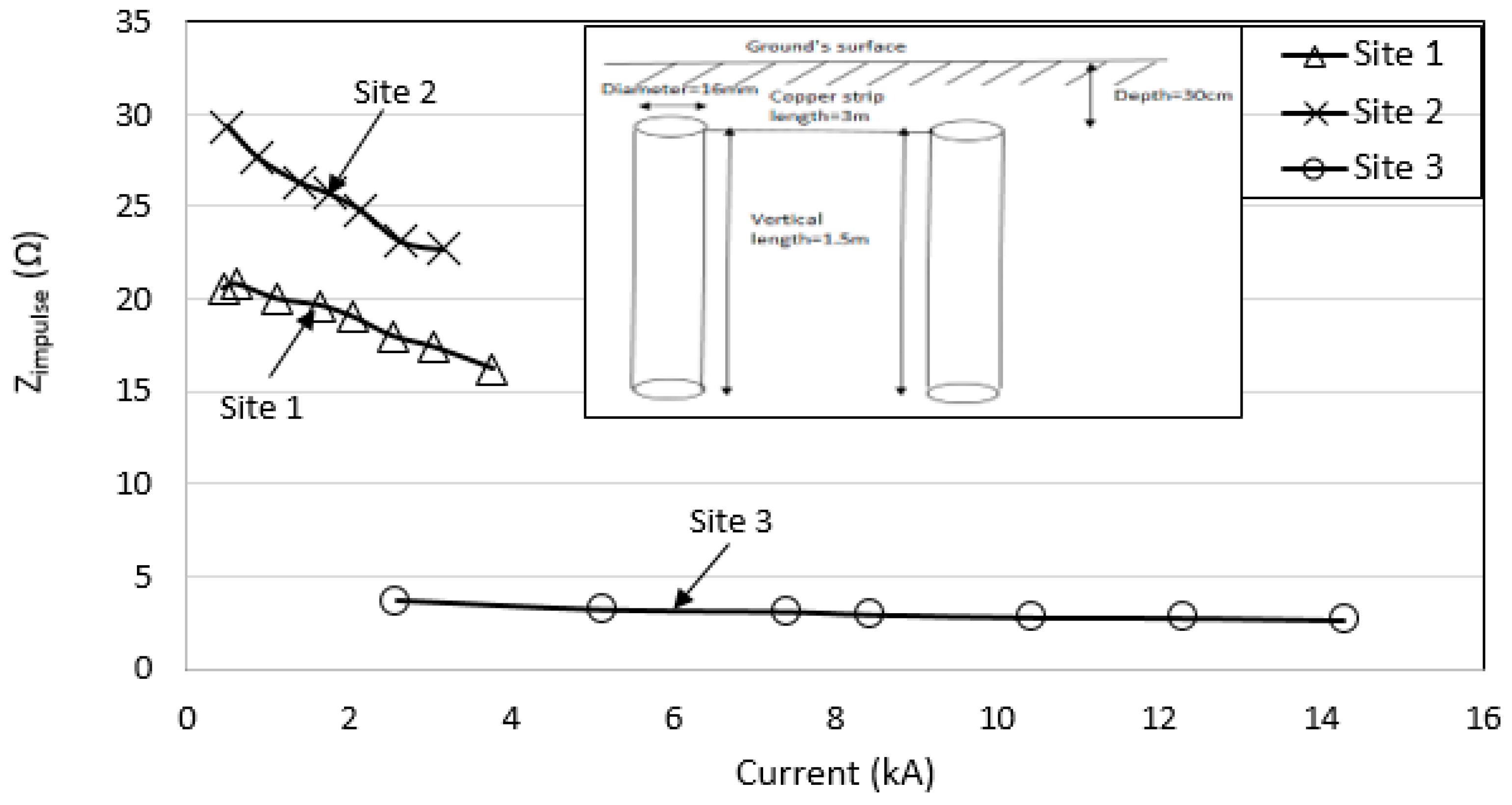
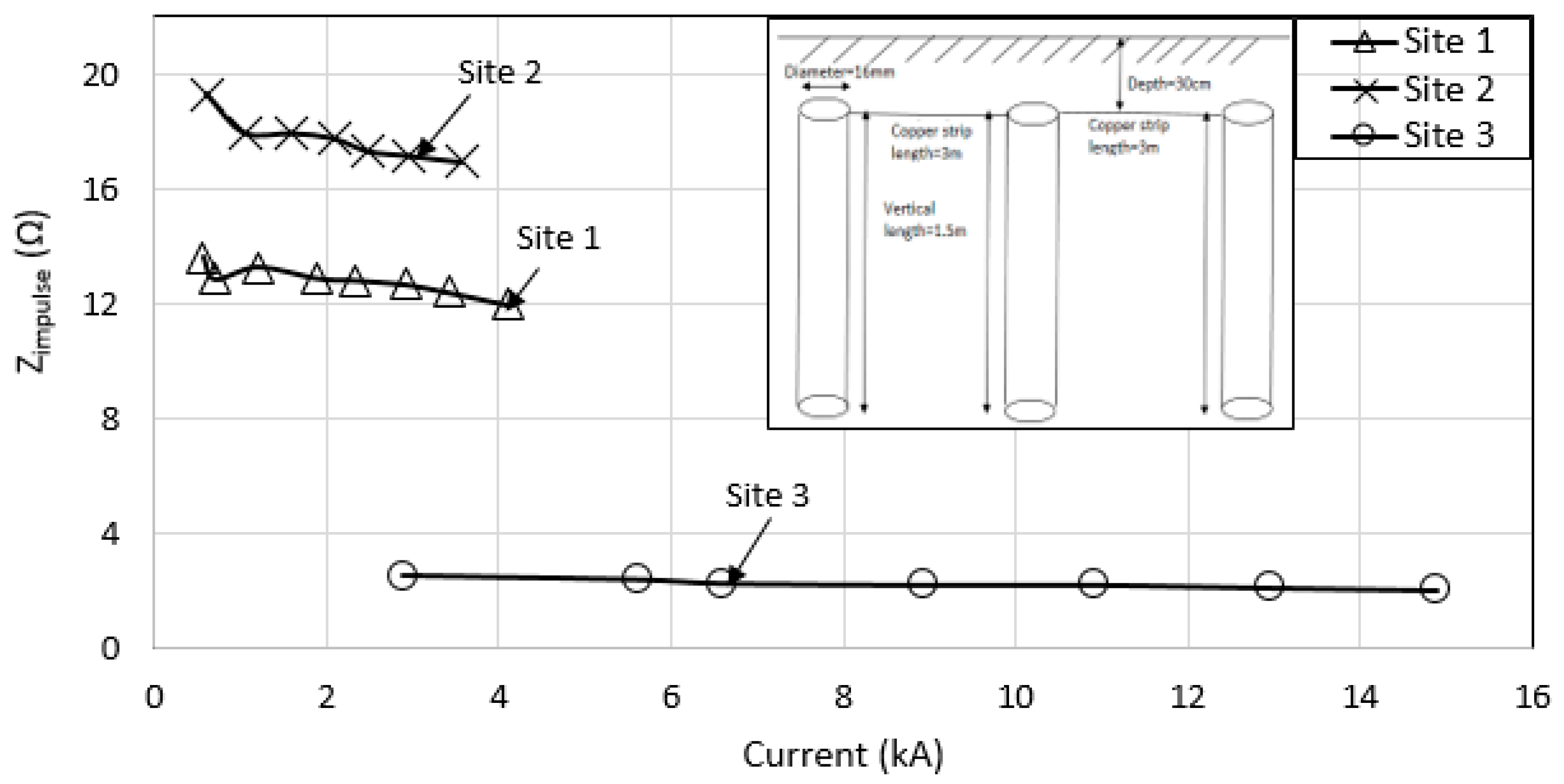
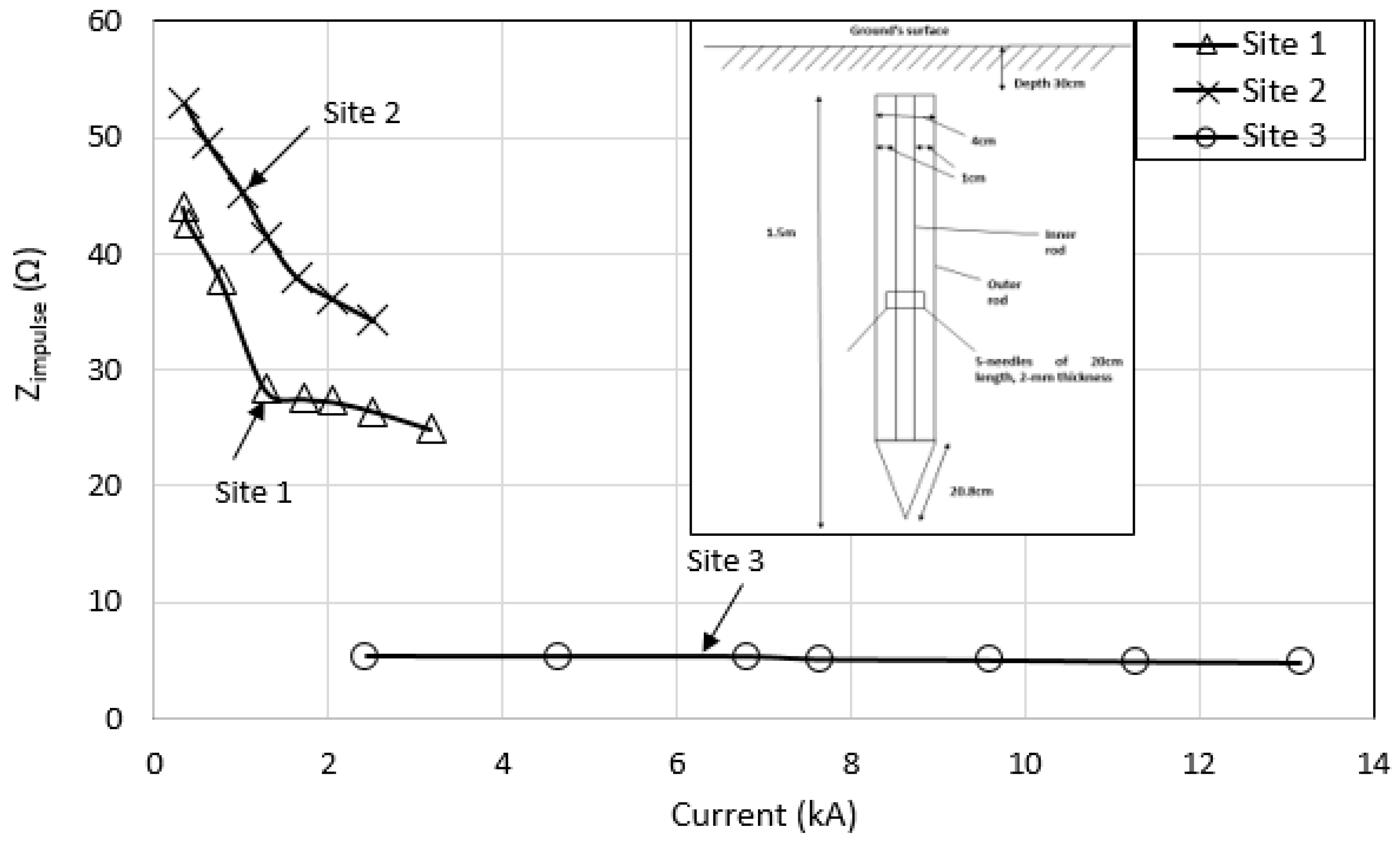
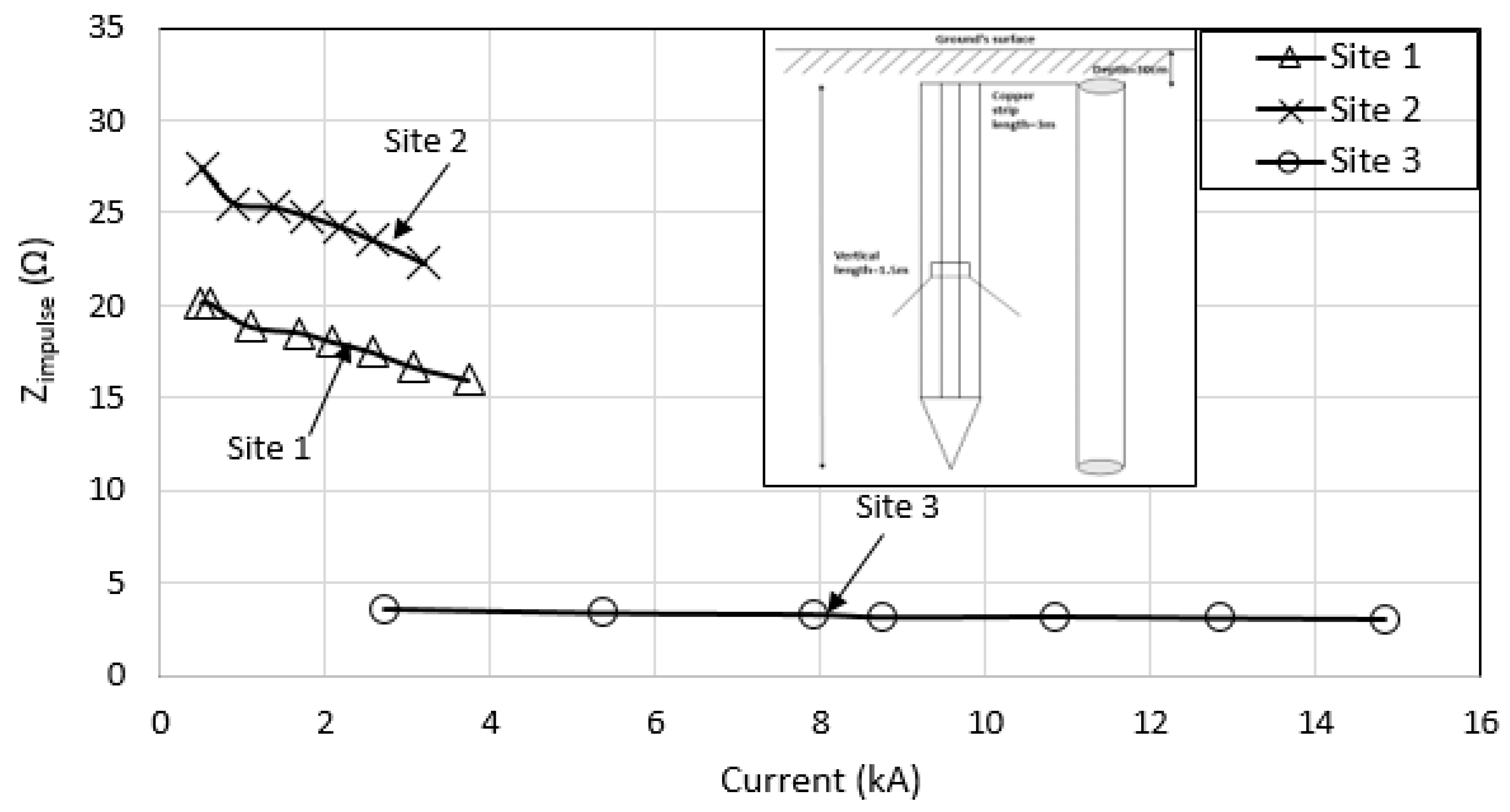

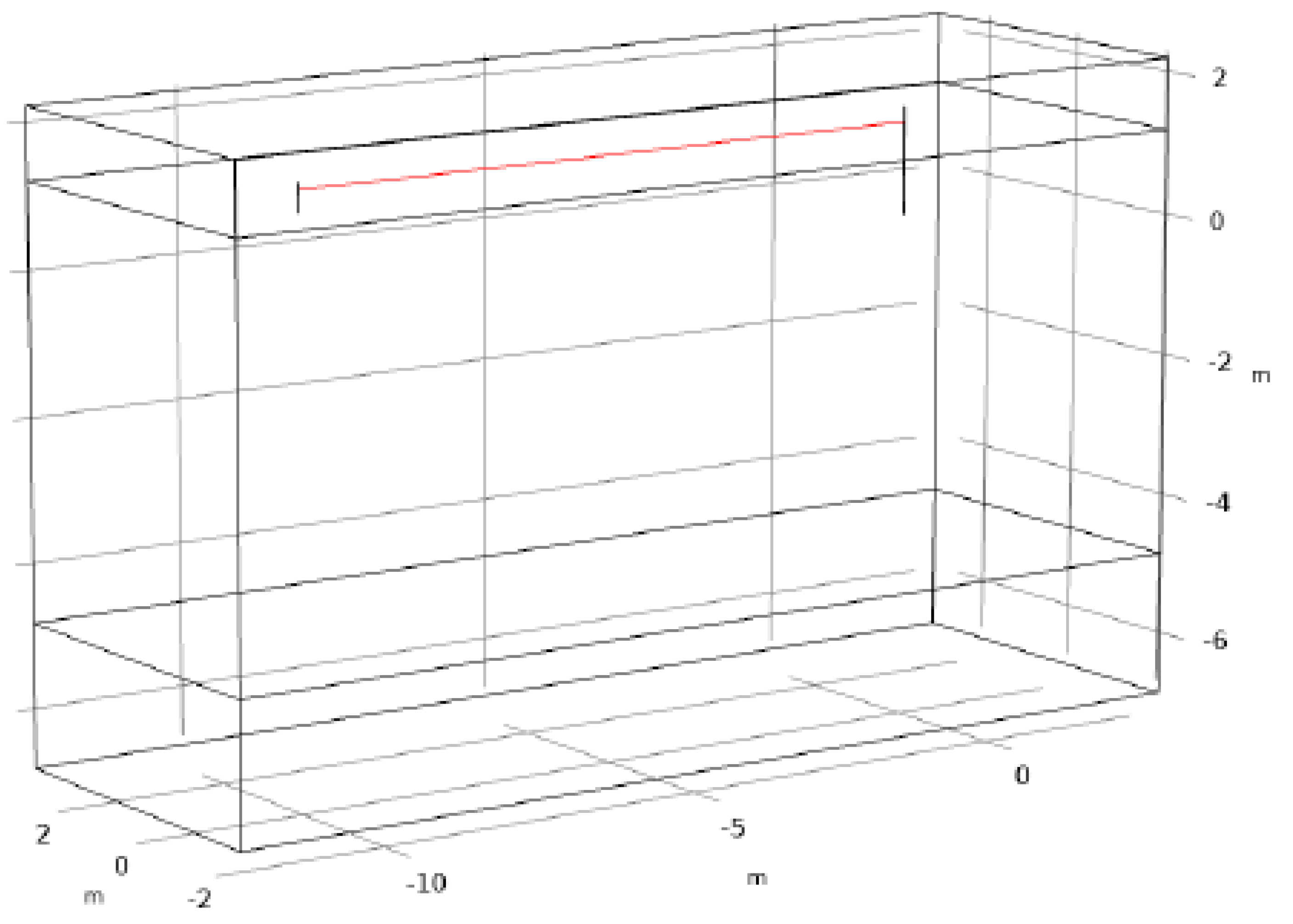
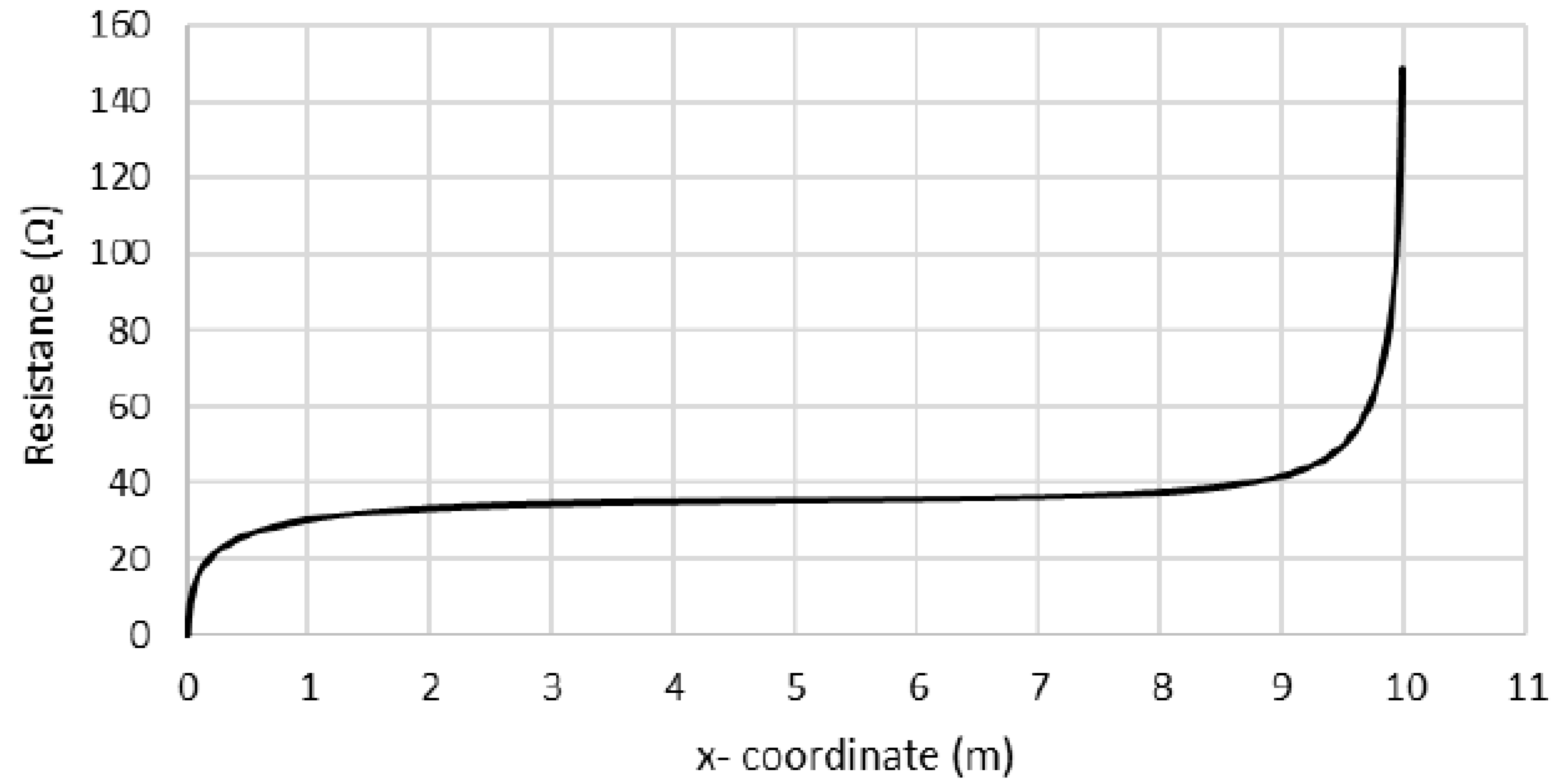
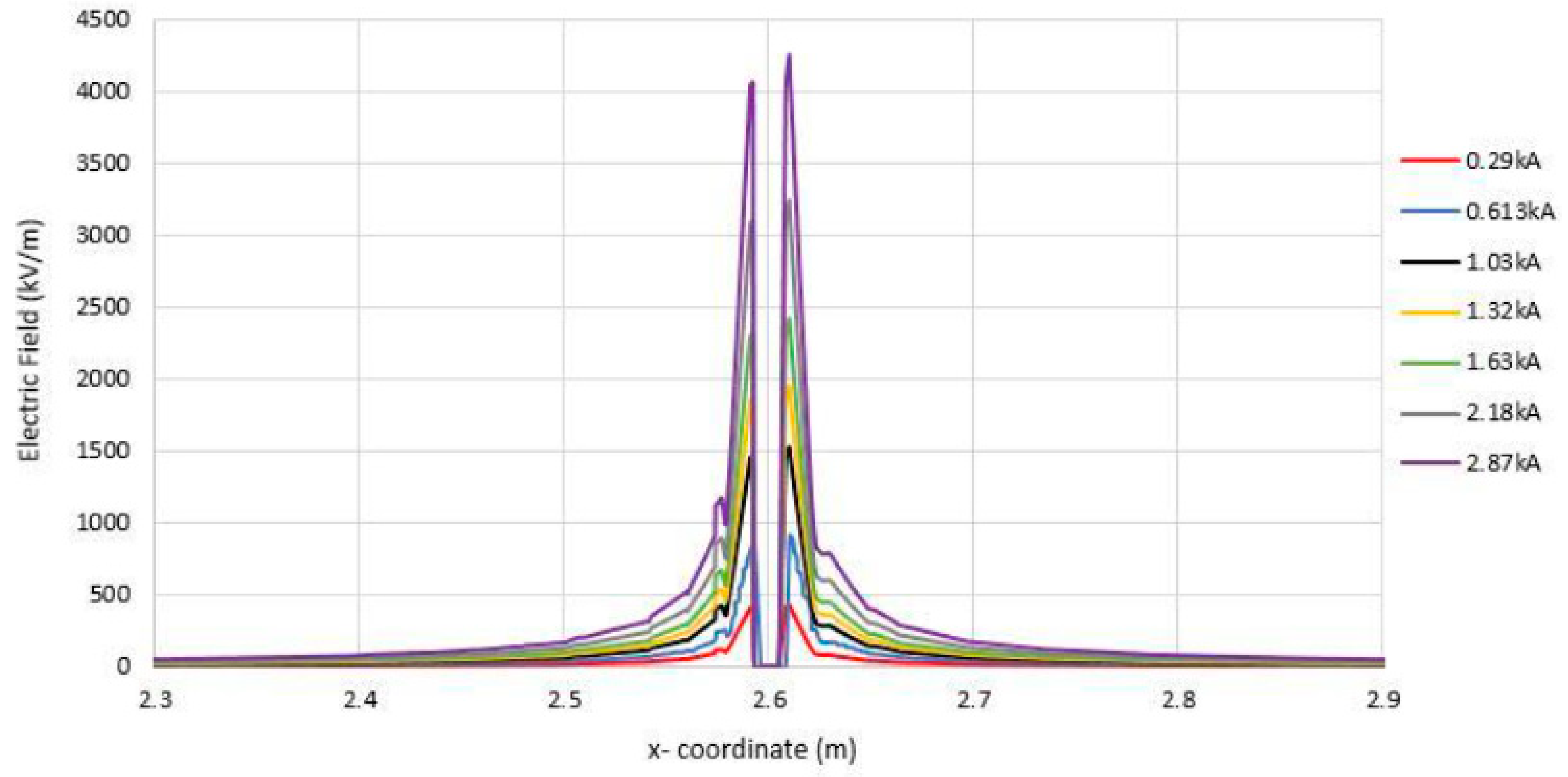
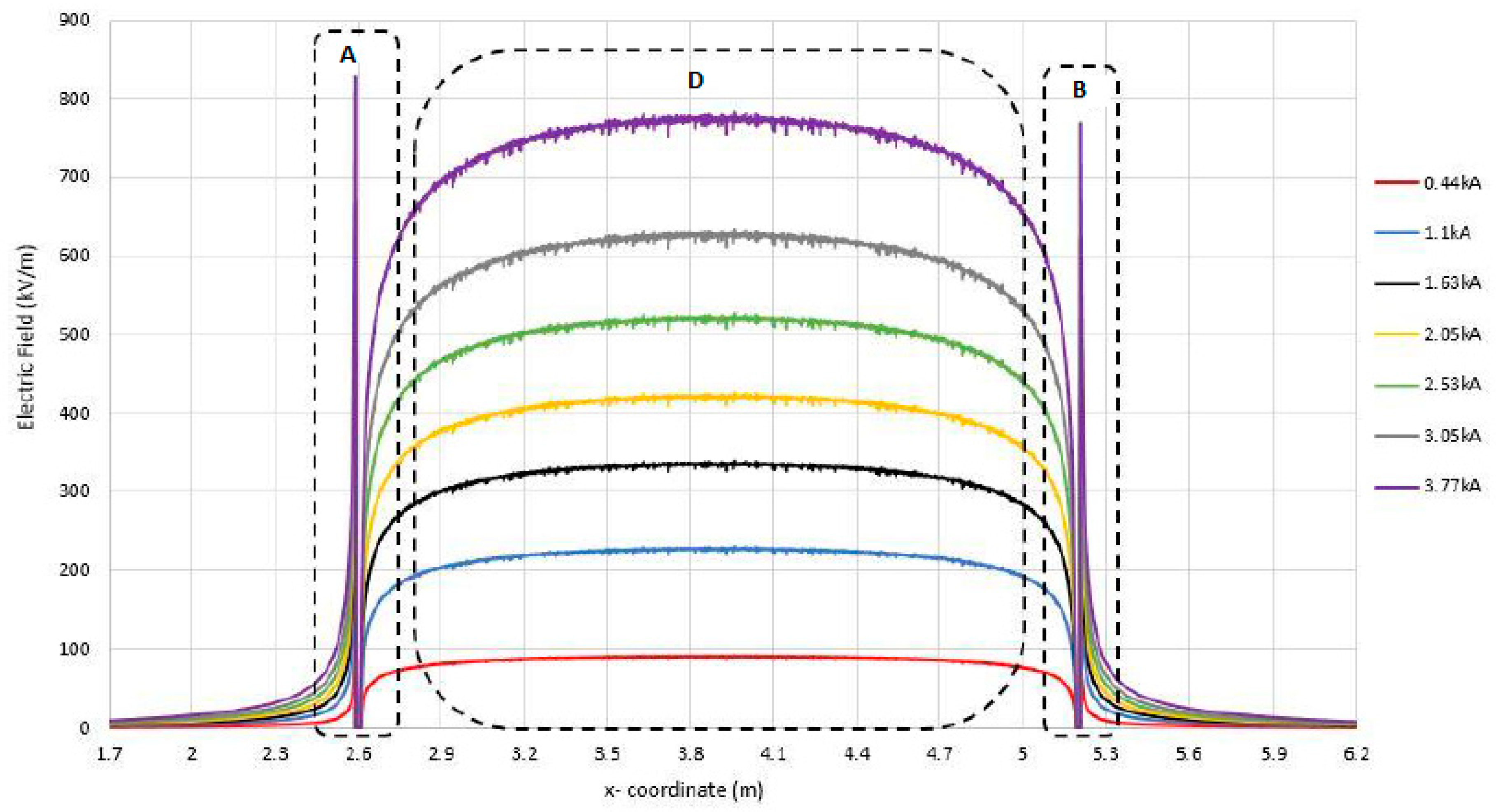
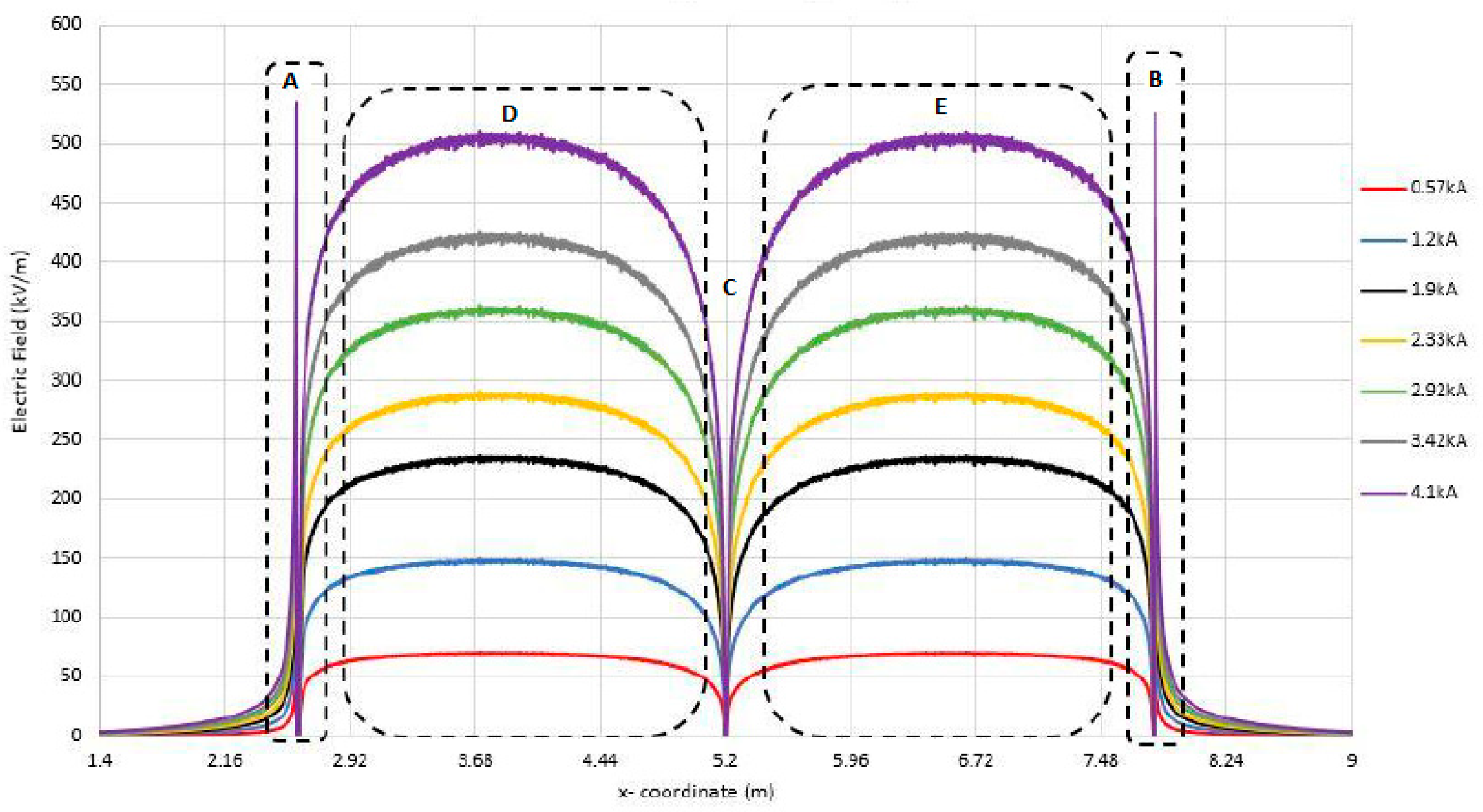


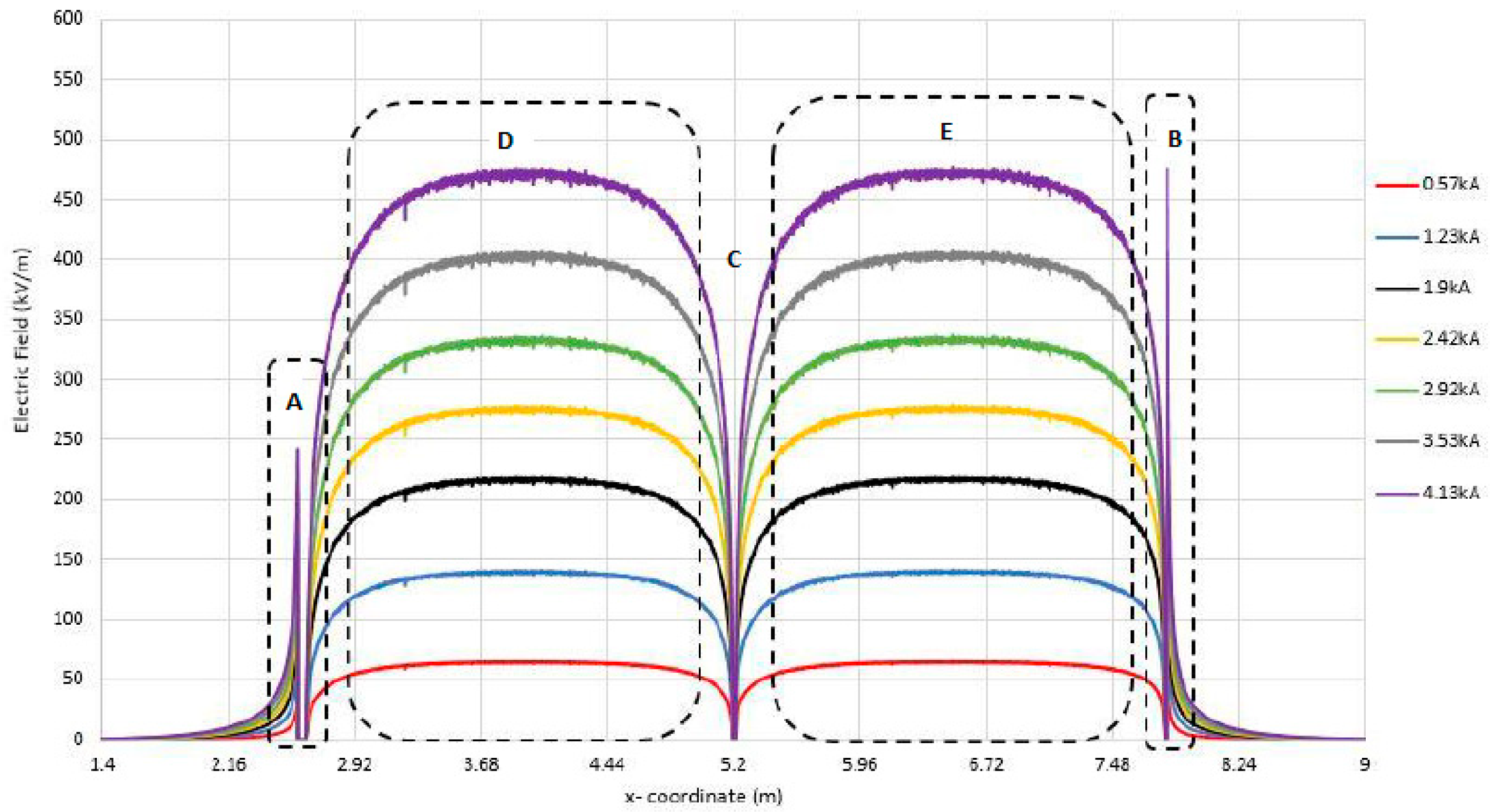
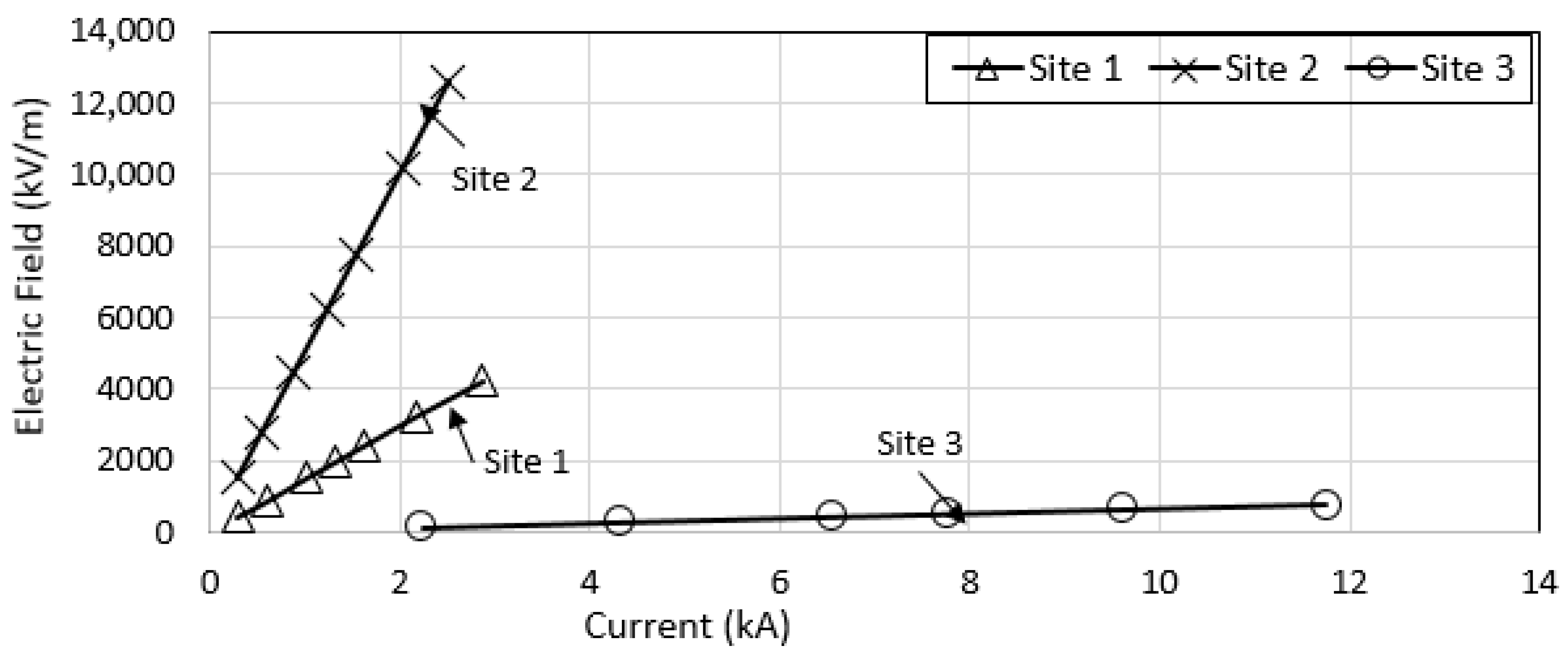

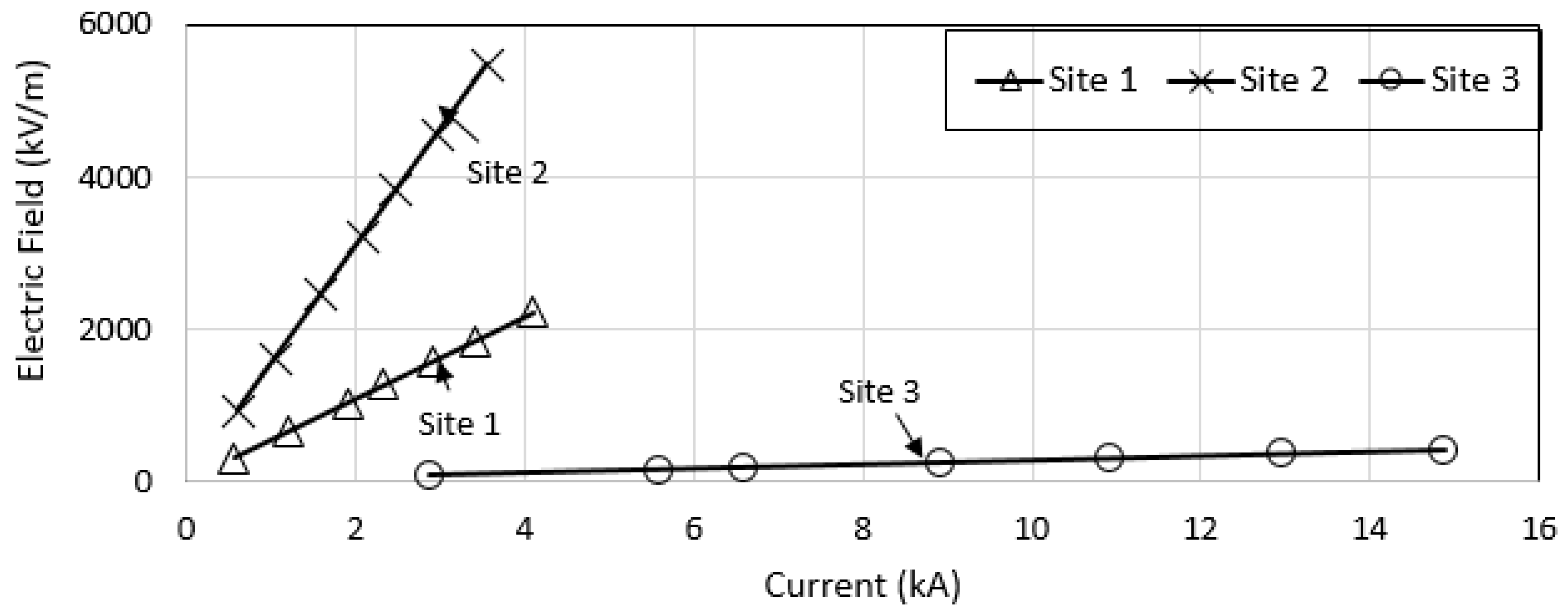
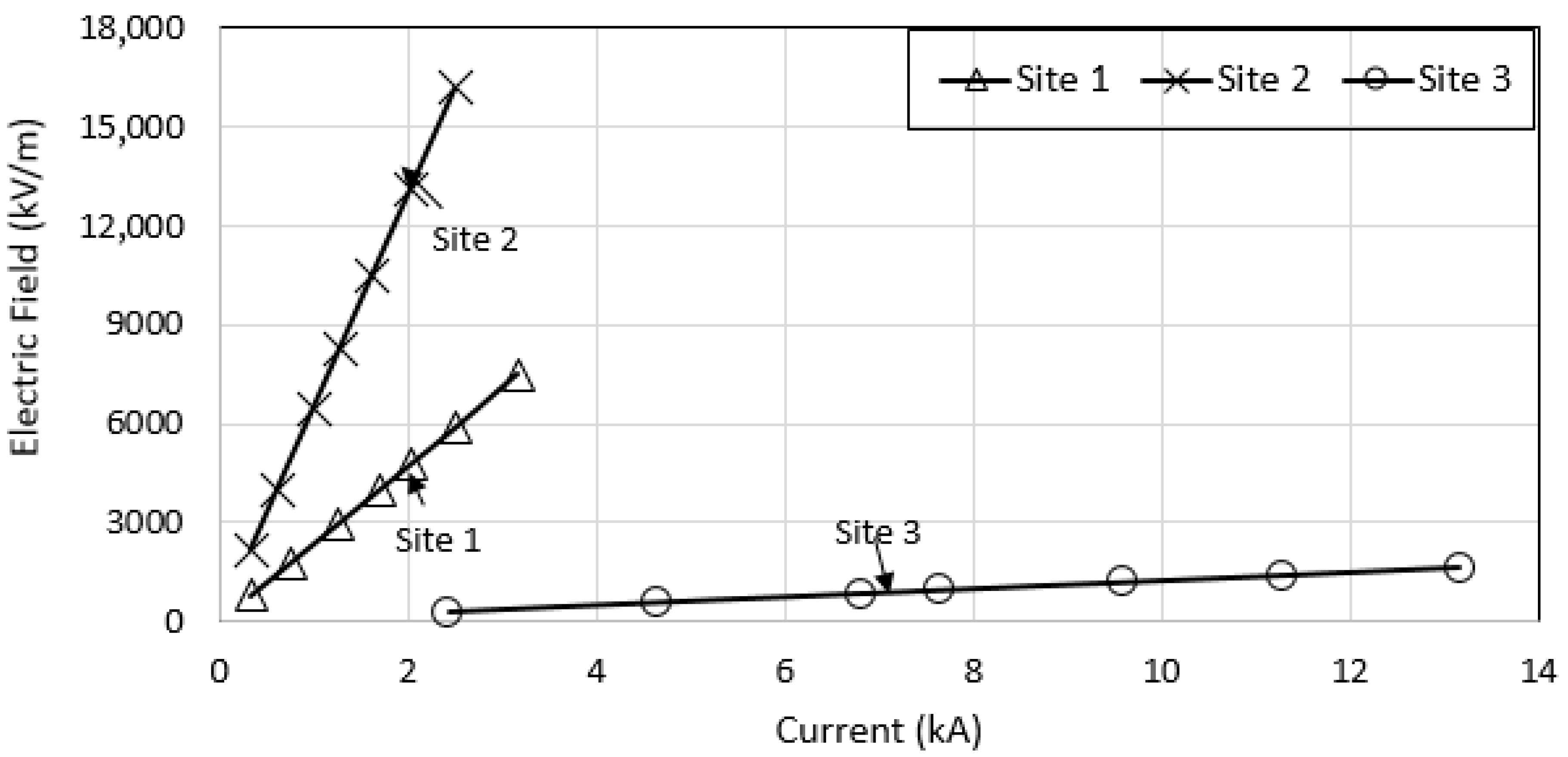
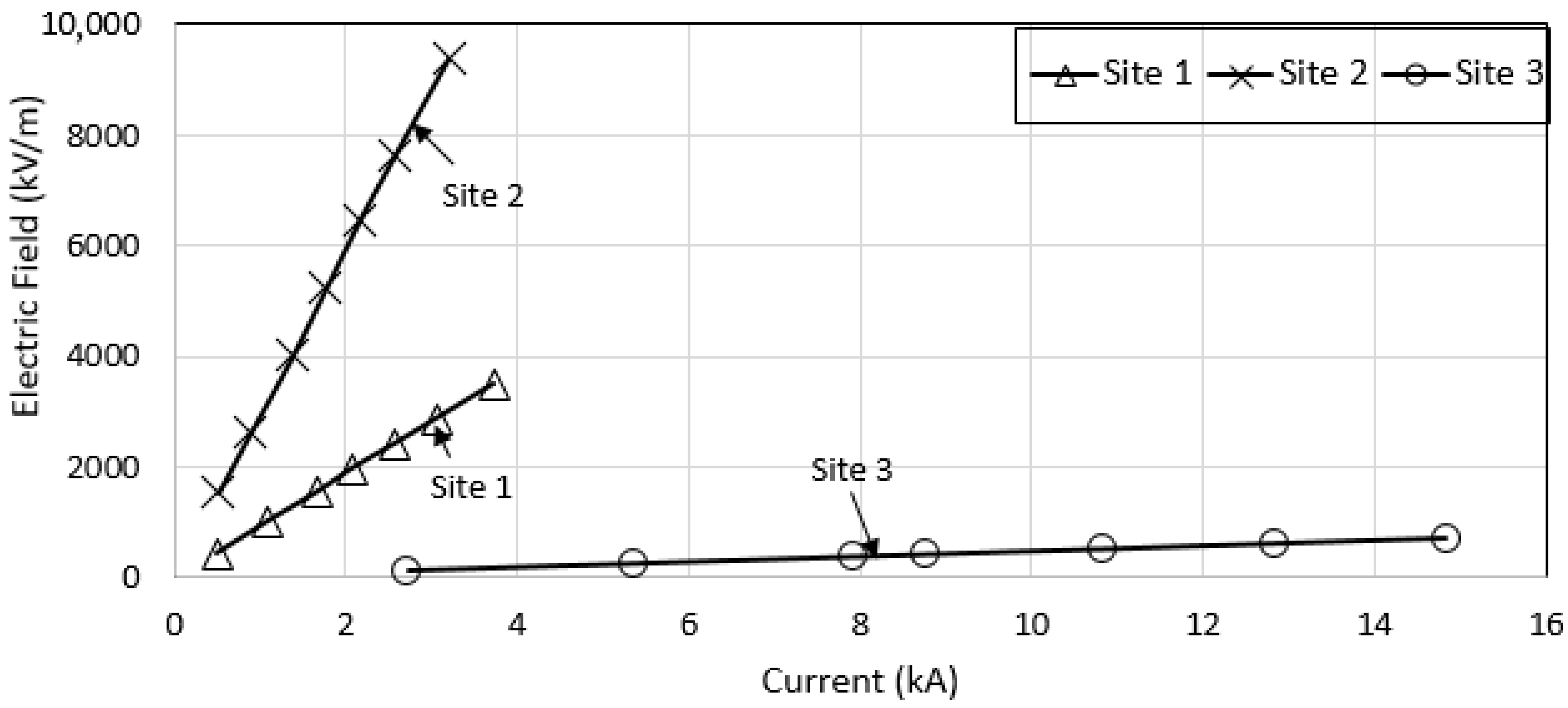
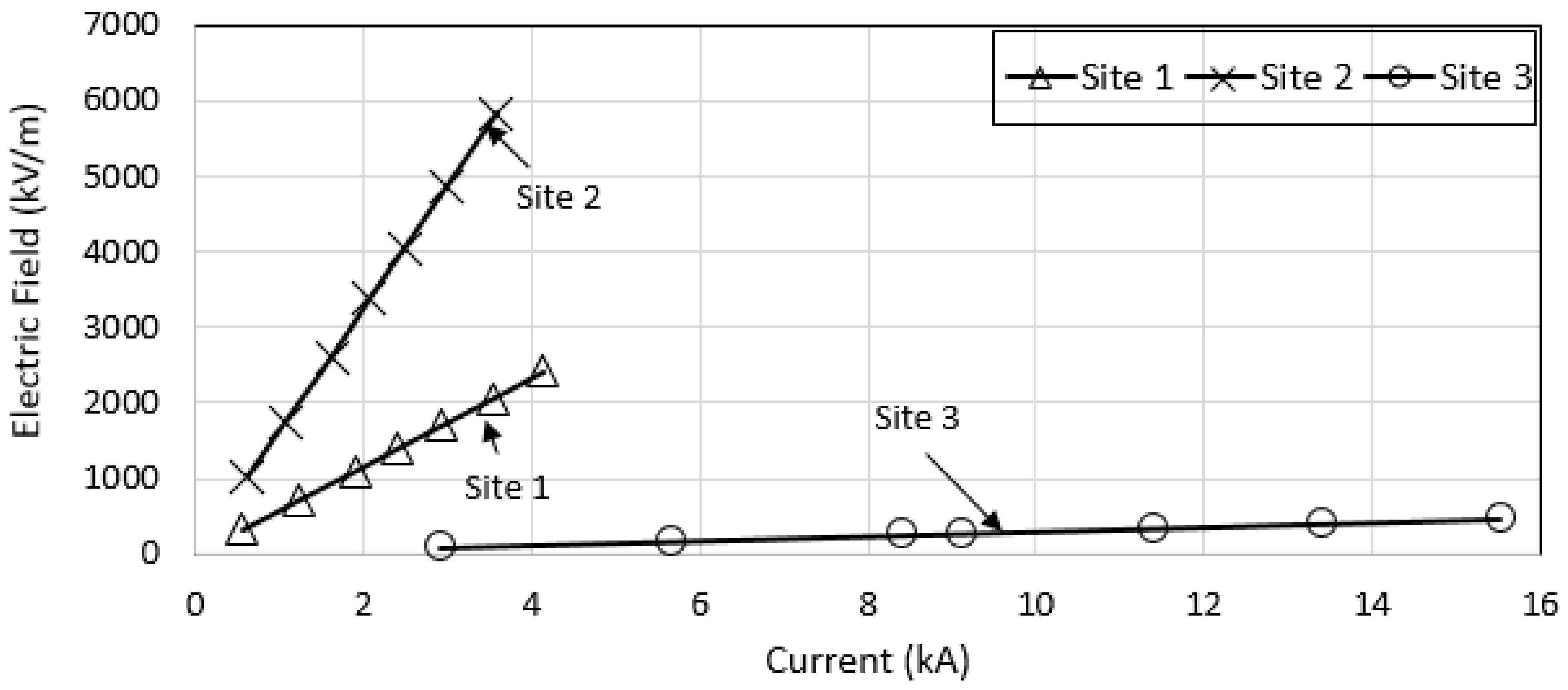
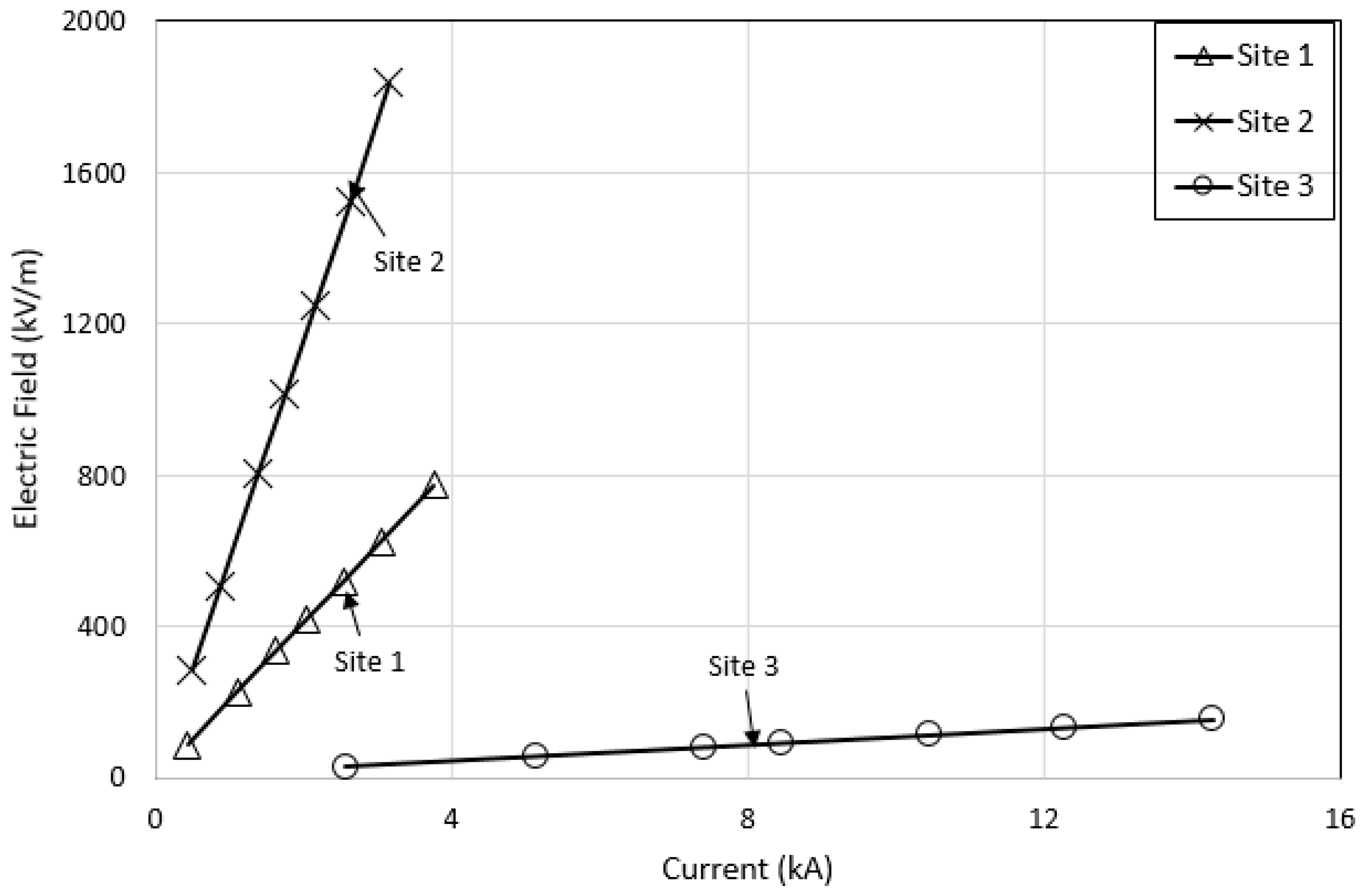

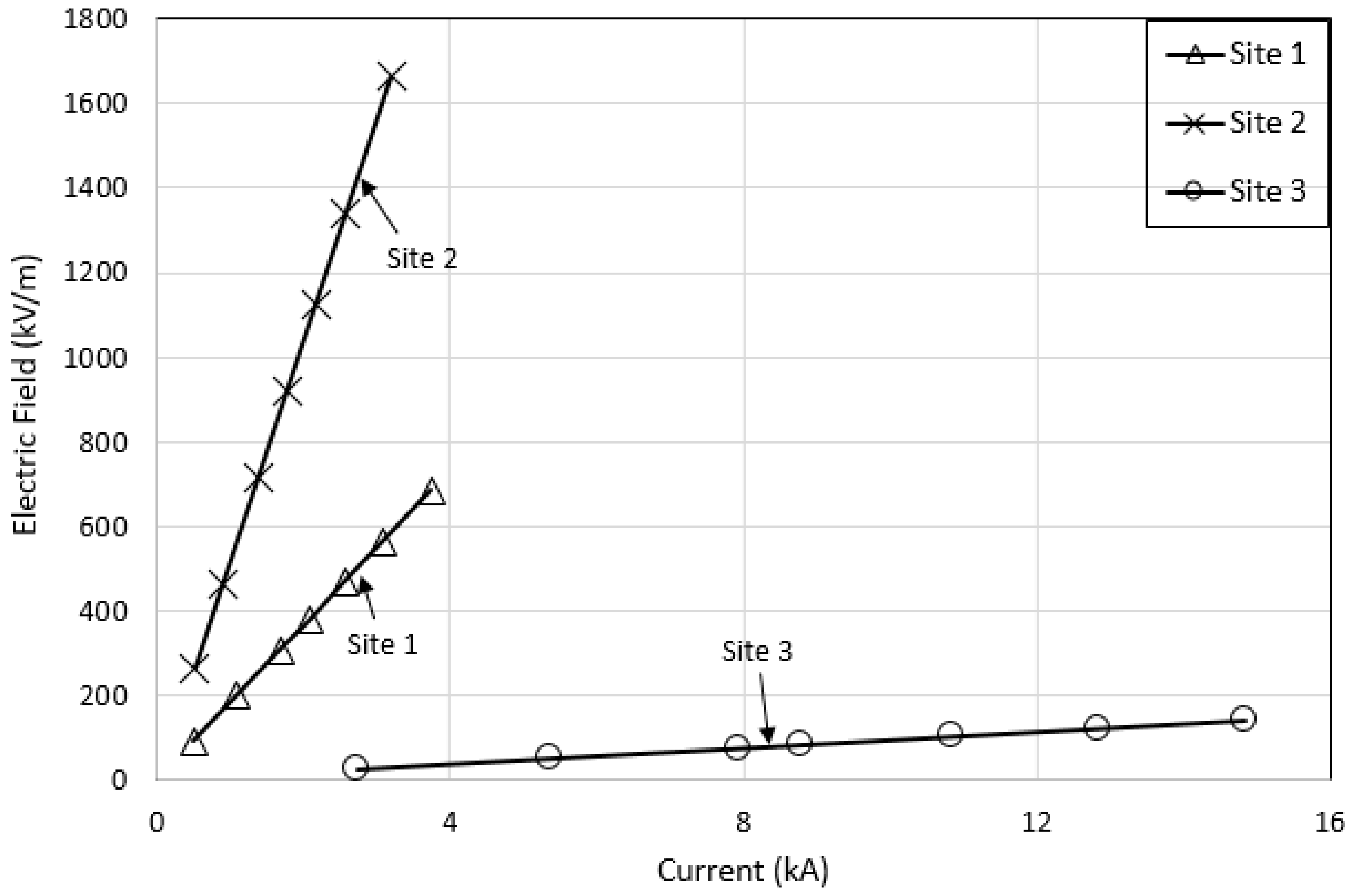
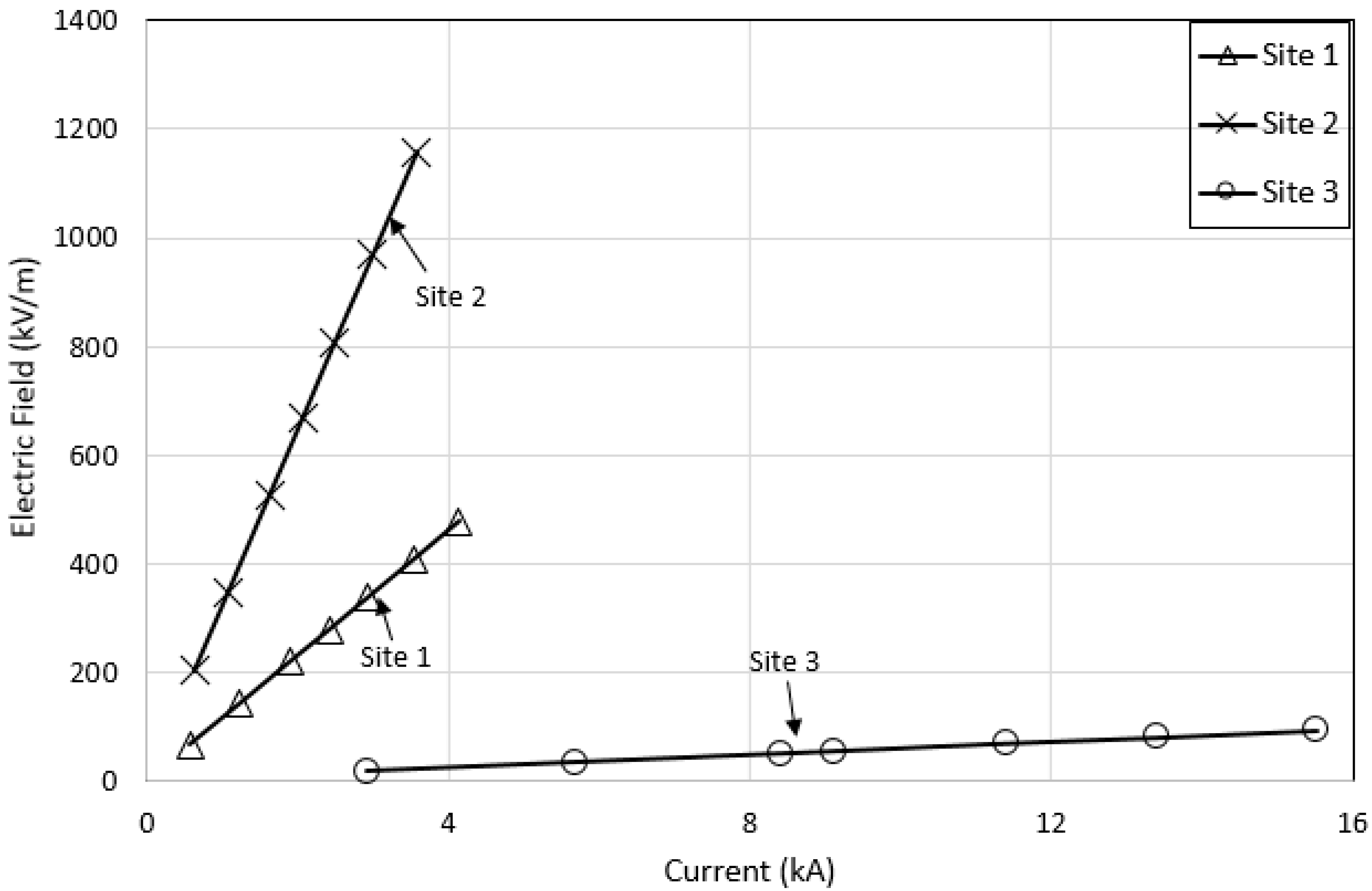
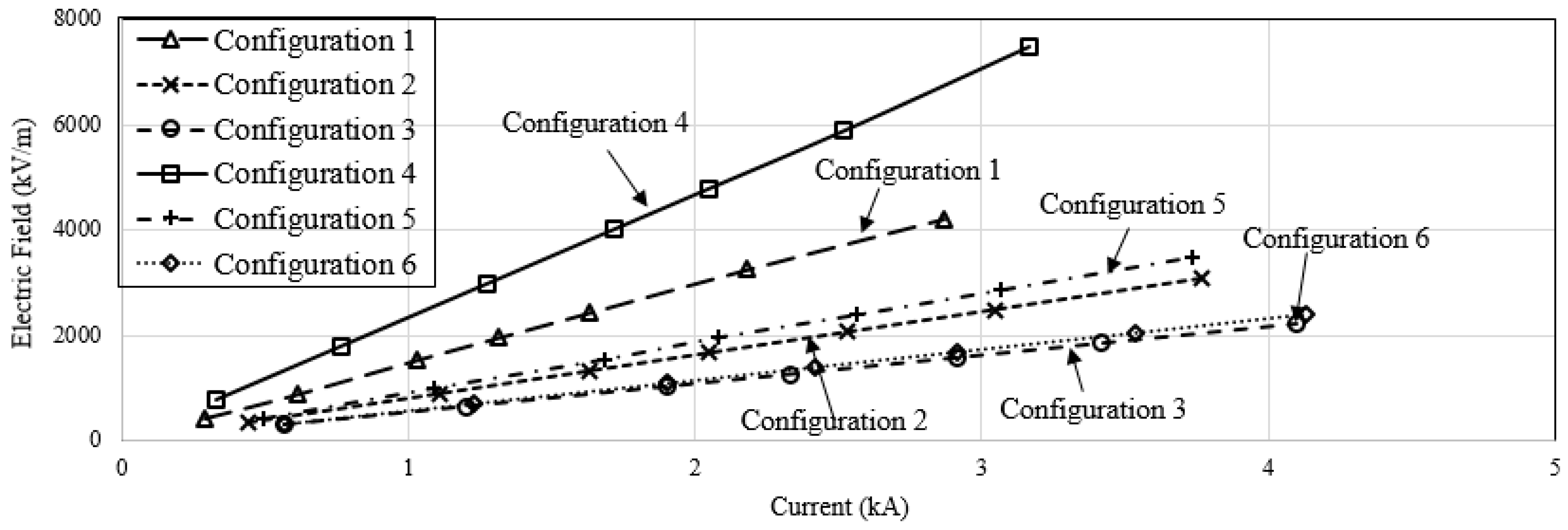

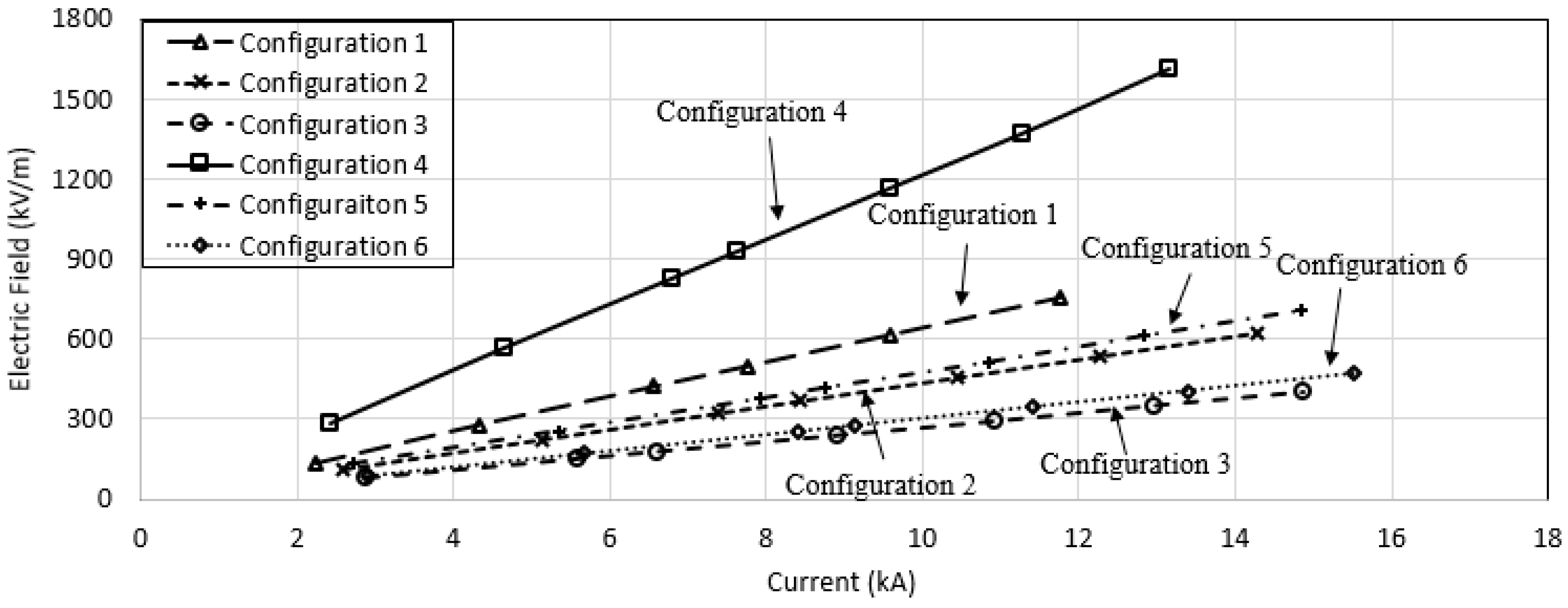
| Configurations of Grounding Systems | |
|---|---|
| Configuration 1 | Configuration 4 |
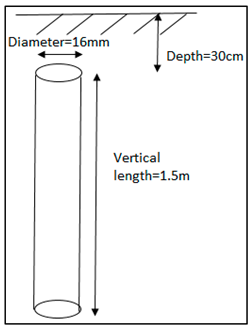 | 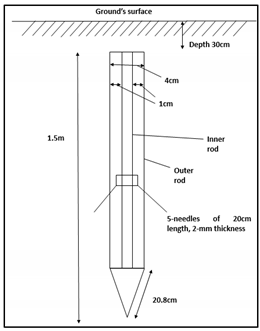 |
| Configuration 2 | Configuration 5 |
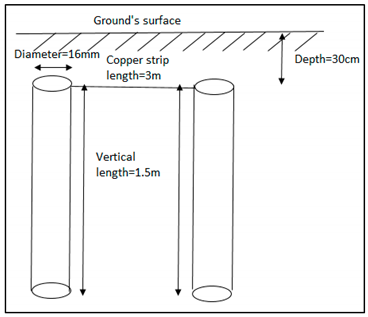 | 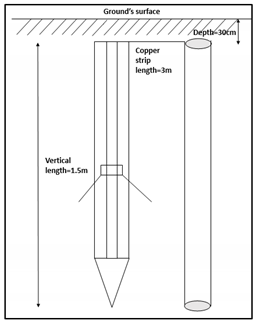 |
| Configuration 3 | Configuration 6 |
 | 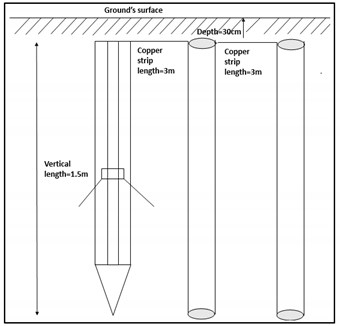 |
| Location | ρ1 (Ω·m−1) | h1 (m) | ρ2 (Ω·m−1) | h2 (m) |
|---|---|---|---|---|
| Site 1 | 57.2 | 6.0 | 758.1 | ∞ |
| Site 2 | 160.4 | 4.3 | 359.6 | ∞ |
| Site 3 | 3 | 4.9 | 0.2 | ∞ |
| Conf. | Earth Electrode | Rdc (Ω) of Ground Electrodes | ||
|---|---|---|---|---|
| Site 1 | Site 2 | Site 3 | ||
| 1 | A vertical single rod electrode | 67.02 | 104.4 | 75.52 |
| 2 | 2 parallel vertical rod electrodes | 25.02 | 44.8 | 27.56 |
| 3 | 3 parallel vertical rod electrodes | 16.6 | 28.5 | 17.81 |
| 4 | GDSR | 53.0 | 67.2 | 18.5 |
| 5 | GDSR in parallel with vertical one rod electrode | 23.4 | 37.6 | 14.6 |
| 6 | GDSR with spike rods in parallel with two vertical rods | 16.21 | 26.6 | 11.33 |
| Conf. | Earth Electrode | Rdc (Ω) of Ground Electrodes | ||
|---|---|---|---|---|
| Site 1 | Site 2 | Site 3 | ||
| 1 | A vertical single rod electrode | 0.85 | 1.54 | 0.04 |
| 2 | 2 parallel vertical rod electrodes | 2.28 | 3.58 | 0.11 |
| 3 | 3 parallel vertical rod electrodes | 3.44 | 5.63 | 0.17 |
| 4 | GDSR | 1.08 | 2.39 | 0.16 |
| 5 | GDSR in parallel with vertical one rod electrode | 2.44 | 4.27 | 0.21 |
| 6 | GDSR with spike rods in parallel with two vertical rods | 3.53 | 6.03 | 0.26 |
| Site | Time to Peak Current for Various Configurations |
|---|---|
| 1 | For the current magnitudes of below 2 kA, the time to peak current is dependent on the electrode configurations; conf. 6 takes the slowest time to peak current, followed by conf. 5, 4, 3, 2 and 1. For the current magnitudes of above 2 kA, the time to peak current is around 10 μs, independent of electrode configurations, constant with increasing currents |
| 2 | For the current magnitudes of below 2.5 kA, the time to peak current is dependent on the electrode configurations; conf. 1 takes the slowest time to peak current. For the current magnitudes of above 2.5 kA, the time to peak current is around 8 μs, independent of electrode configurations, constant with increasing currents. |
| 3 | For the current magnitudes of below 9 kA, the times to peak current are quite close to each other; conf. 5 takes the slowest time to peak current. For the current magnitudes of above 9 kA, the time to peak current is around 7 μs, independent of electrode configurations, constant with increasing currents. |
| Configuration | Time to Peak Current at Various Sites |
|---|---|
| 1 | Conf. 1 installed at site 2 has the highest time to peak current. Time to peak current decreases with increasing current, for conf. 1 at all sites |
| 2 | Configurations installed at site 1 have the highest time to peak current. Time to peak current decreases with increasing current, for all sites |
| 3 | |
| 4 | |
| 5 | |
| 6 |
| Site | Time for Current to Discharge to Zero for Various Configurations |
|---|---|
| 1 | The time for the current to discharge to zero decreases with increasing applied voltage for all configurations. Configuration 1 takes the slowest time for the current to discharge to the ground, followed by configuration 4, 2, 5, 3 and 6. This trend shows that the time for the current to discharge to the ground is highly dependent on Rdc values, where the higher the Rdc value, the longer the time taken for the current to discharge to zero. |
| 2 | |
| 3 | Only configuration 4 has a significant reduction of time for the current to discharge to zero with increasing applied voltage, while the time for the current to discharge to zero for other configurations is nearly constant with increasing applied voltage, hardly dependent on Rdc values. |
| Configuration | Time for Current to Discharge to Zero at Various Sites |
|---|---|
| 1 | All configurations installed at sites 1 and 2 have the time for the current to discharge to zero decrease with increasing applied voltage, while configurations installed at low soil resistivity (site 3) are almost constant with increasing applied voltage (except for configuration 4). |
| 2 | |
| 3 | |
| 4 | |
| 5 | |
| 6 |
| Site | Time for Current to Discharge to Zero for Various Configurations |
|---|---|
| 1 | The higher the Rdc, the higher is the Zimpulse for all sites. The non-linearity, or reduction of Zimpulse with increasing current is clearly seen for configurations 1 and 4 (high Rdc). While, Zimpulse is almost constant with increasing current for other configurations. |
| 2 | |
| 3 |
| Configuration | Zimpulse at Various Sites |
|---|---|
| 1 | Close Zimpulse values for configuration 1 installed at sites 1 and 2. A significant reduction in Zimpulse values with increasing current for configuration 1 installed at sites 1 and 2, while Zimpulse are almost constant, independent of current magnitudes for configuration 1 installed at site 3, due to low soil resistivity. |
| 2 | Zimpulse values for configurations 2–6 installed at site 2 are always higher than those installed at site 1. A significant reduction in Zimpulse values for configurations installed at sites 1 and 2, while Zimpulse values are almost constant, independent of current magnitudes for configurations installed at site 3, due to low soil resistivity. |
| 3 | |
| 4 | |
| 5 | |
| 6 |
| Conf. | Earth Electrode | Rdc Values (Ω) | ||||||||
|---|---|---|---|---|---|---|---|---|---|---|
| Site 1 | Site 2 | Site 3 | ||||||||
| Meas. | Comp. | Meas. | Comp. | Meas. | Comp. | |||||
| FEM | CDEGS | FEM | CDEGS | FEM | CDEGS | |||||
| 1 | A vertical single rod electrode | 67.02 | 35.4 | 34.9 | 104.4 | 100.1 | 97.1 | 75.52 | 1.84 | 1.7 |
| 2 | 2 parallel vertical rod electrodes | 25.02 | 13.3 | 15.2 | 44.8 | 36.5 | 40.3 | 27.56 | 0.68 | 0.65 |
| 3 | 3 parallel vertical rod electrodes | 16.6 | 18.3 | 10.2 | 28.5 | 23.14 | 26.1 | 17.81 | 0.43 | 0.42 |
| 4 | GDSR | 53.0 | 25.4 | 28.3 | 67.2 | 71.1 | 78.3 | 18.5 | 1.31 | 1.37 |
| 5 | GDSR in parallel with vertical one rod electrode | 23.4 | 11.78 | 14.2 | 37.6 | 32.9 | 39.4 | 14.6 | 0.61 | 0.61 |
| 6 | GDSR with spike rods in parallel with two vertical rods | 16.21 | 7.69 | 10.3 | 26.6 | 21.5 | 26.8 | 11.33 | 0.4 | 0.38 |
| Configuration | Electric Field Values for Various Configurations |
|---|---|
| 1 | Electric field values increase with increasing current magnitudes for all configurations, with the highest electric field occurring at the rod electrodes. For all sites, configuration 4 has the highest electric field, followed by configuration 1. The largest difference in electric field is seen between configuration 1 and 4, in comparison to configuration 2 and 5, and 3 and 6. For the same configuration, site 2 has the highest electric field, and a steep increase with increasing current magnitudes, with site 3 having the smallest electric field, with a small increase in electric field with increasing current magnitudes, for all configurations. |
| 2 | |
| 3 | |
| 4 | |
| 5 | |
| 6 | |
| 2 | |
| 3 | |
| 4 | |
| 5 | |
| 6 |
© 2020 by the authors. Licensee MDPI, Basel, Switzerland. This article is an open access article distributed under the terms and conditions of the Creative Commons Attribution (CC BY) license (http://creativecommons.org/licenses/by/4.0/).
Share and Cite
Abdul Ali, A.W.; Ahmad, N.N.; Mohamad Nor, N.; Idris, N.F.; Hanaffi, F. Investigations on the Performance of Grounding Device with Spike Rods (GDSR) with the Effects of Soil Resistivity and Configurations. Energies 2020, 13, 3538. https://doi.org/10.3390/en13143538
Abdul Ali AW, Ahmad NN, Mohamad Nor N, Idris NF, Hanaffi F. Investigations on the Performance of Grounding Device with Spike Rods (GDSR) with the Effects of Soil Resistivity and Configurations. Energies. 2020; 13(14):3538. https://doi.org/10.3390/en13143538
Chicago/Turabian StyleAbdul Ali, Abdul Wali, Nurul Nadia Ahmad, Normiza Mohamad Nor, Nur Farahi Idris, and Farhan Hanaffi. 2020. "Investigations on the Performance of Grounding Device with Spike Rods (GDSR) with the Effects of Soil Resistivity and Configurations" Energies 13, no. 14: 3538. https://doi.org/10.3390/en13143538
APA StyleAbdul Ali, A. W., Ahmad, N. N., Mohamad Nor, N., Idris, N. F., & Hanaffi, F. (2020). Investigations on the Performance of Grounding Device with Spike Rods (GDSR) with the Effects of Soil Resistivity and Configurations. Energies, 13(14), 3538. https://doi.org/10.3390/en13143538






